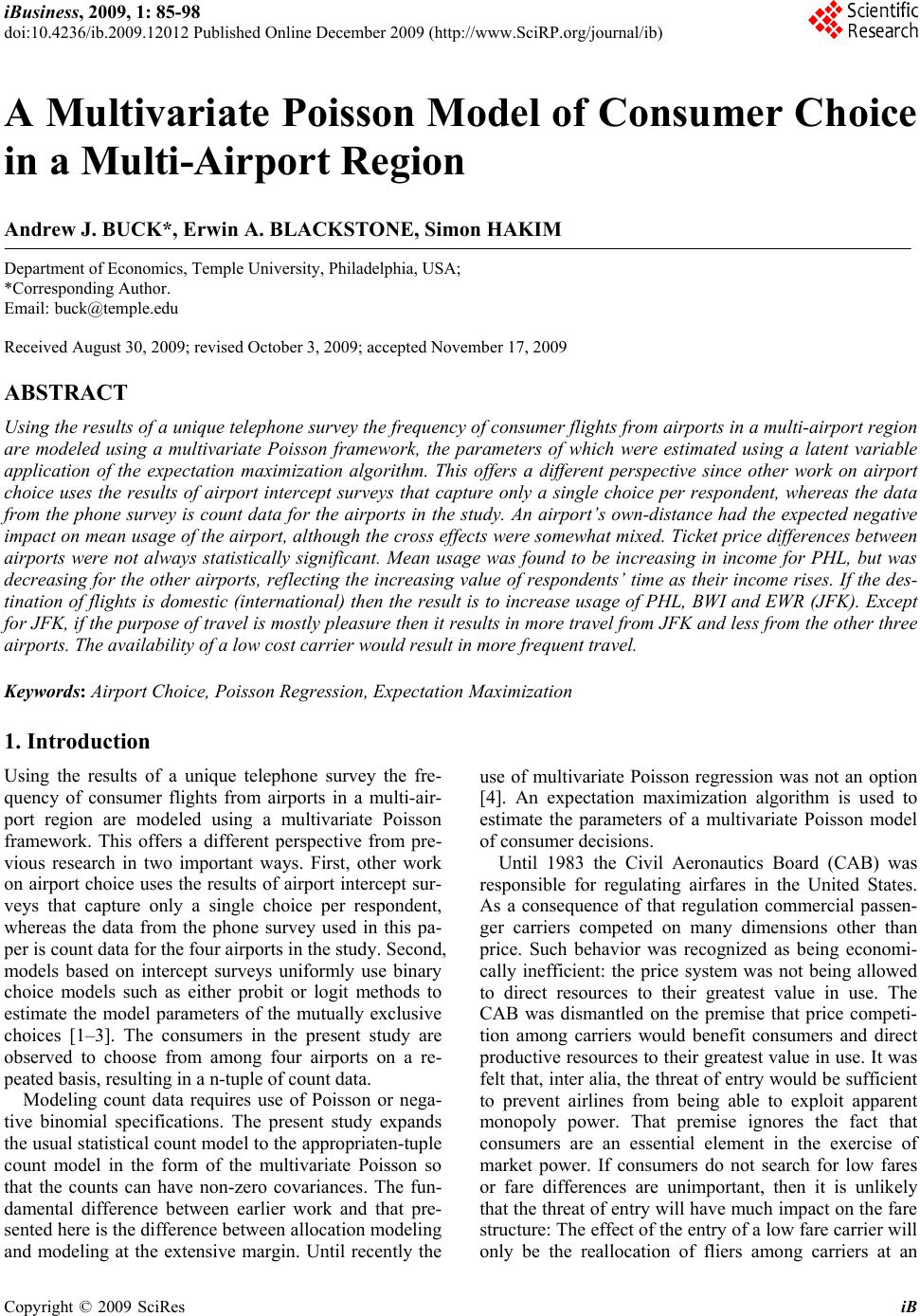 iBusiness, 2009, 1: 85-98 doi:10.4236/ib.2009.12012 Published Online December 2009 (http://www.SciRP.org/journal/ib) Copyright © 2009 SciRes iB 85 A Multivariate Poisson Model of Consumer Choice in a Multi-Airport Region Andrew J. BUCK*, Erwin A. BLACKSTONE, Simon HAKIM Department of Economics, Temple University, Philadelphia, USA; *Corresponding Author. Email: buck@temple.edu Received August 30, 2009; revised October 3, 2009; accepted November 17, 2009 ABSTRACT Using the results of a uniqu e telephone survey th e frequency of cons umer flights from airports in a multi-airport reg ion are modeled using a multivariate Poisson framework, the parameters of which were estimated using a latent variable application of the expectation maximization algorithm. This offers a different perspective since other work on airport choice uses the results of airport intercept surveys that capture only a single choice per respondent, whereas the data from the phone survey is count data for the airports in the study. An airport’s own-distance had the expected negative impact on mean usage of the airport, although the cross effects were somewhat mixed. Ticket price differences between airports were not always statistically significant. Mean usage was found to be increasing in income for PHL, but was decreasing for the other airports, reflecting the increasing value of respondents’ time as their income rises. If the des- tination of flights is domestic (international) then the result is to increase usage of PHL, BWI and EWR (JFK). Except for JFK, if the purpose of travel is mostly p leasure then it results in mo re travel from JFK a nd less from the other th ree airports. The availability of a low cost carrier wou ld result in more frequent travel. Keywords: Airport Choice, Poisson Regression, Expectation Maximization 1. Introduction Using the results of a unique telephone survey the fre- quency of consumer flights from airports in a multi-air- port region are modeled using a multivariate Poisson framework. This offers a different perspective from pre- vious research in two important ways. First, other work on airport choice uses the results of airport intercept sur- veys that capture only a single choice per respondent, whereas the data from the phone survey used in this pa- per is count data for the four airports in the study. Second, models based on intercept surveys uniformly use binary choice models such as either probit or logit methods to estimate the model parameters of the mutually exclusive choices [1–3]. The consumers in the present study are observed to choose from among four airports on a re- peated basis, resulting in a n-tuple of count data. Modeling count data requires use of Poisson or nega- tive binomial specifications. The present study expands the usual statistical count model to the appropriaten-tuple count model in the form of the multivariate Poisson so that the counts can have non-zero covariances. The fun- damental difference between earlier work and that pre- sented here is the difference between allocation modeling and modeling at the extensive margin. Until recently the use of multivariate Poisson regression was not an option [4]. An expectation maximization algorithm is used to estimate the parameters of a multivariate Poisson model of consumer decisions. Until 1983 the Civil Aeronautics Board (CAB) was responsible for regulating airfares in the United States. As a consequence of that regulation commercial passen- ger carriers competed on many dimensions other than price. Such behavior was recognized as being economi- cally inefficient: the price system was not being allowed to direct resources to their greatest value in use. The CAB was dismantled on the premise that price competi- tion among carriers would benefit consumers and direct productive resources to their greatest value in use. It was felt that, inter alia, the threat of entry would be sufficient to prevent airlines from being able to exploit apparent monopoly power. That premise ignores the fact that consumers are an essential element in the exercise of market power. If consumers do not search for low fares or fare differences are unimportant, then it is unlikely that the threat of entry will have much impact on the fare structure: The effect of the entry of a low fare carrier will only be the reallocation of fliers among carriers at an 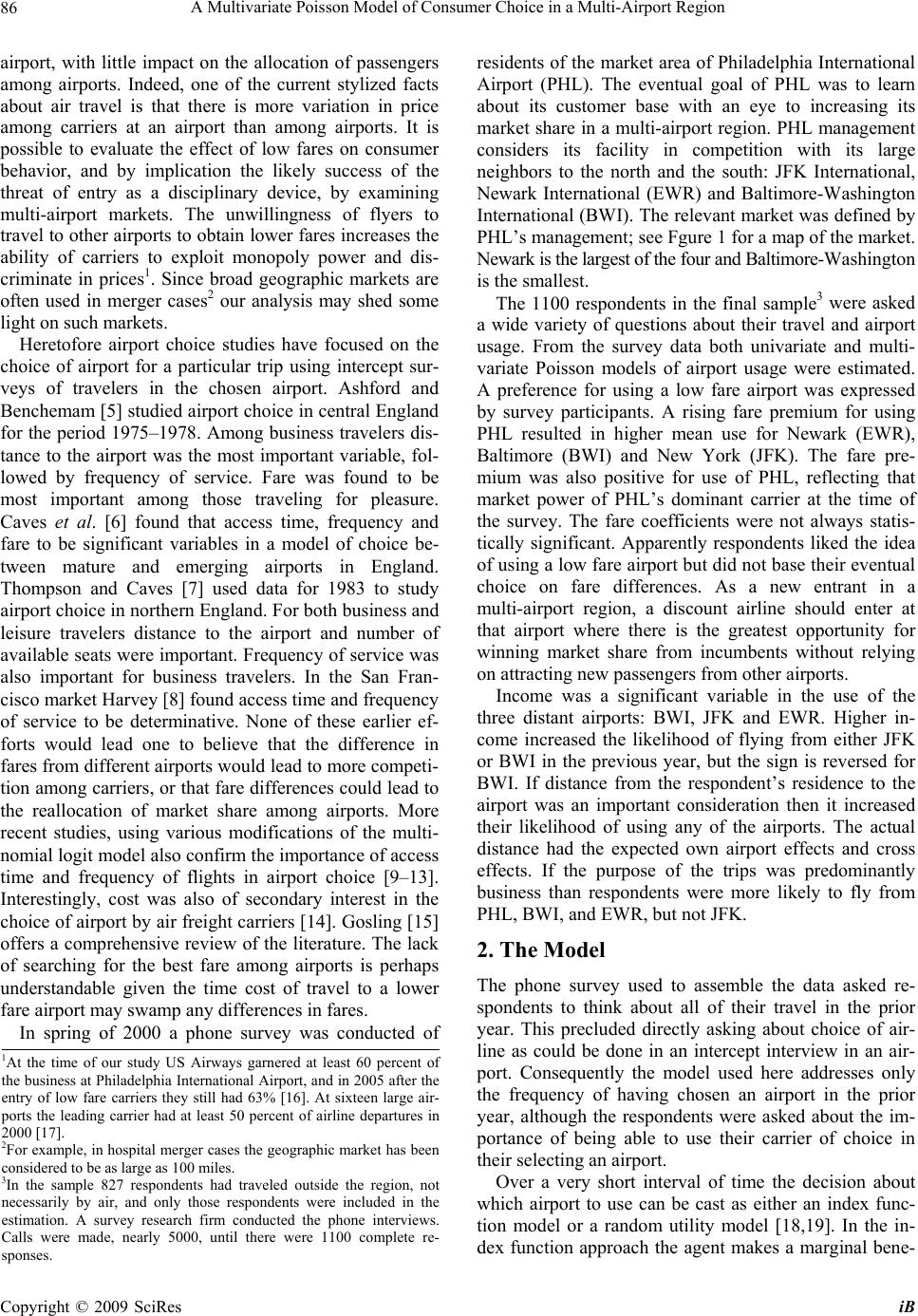 A Multivariate Poisson Model of Consumer Choice in a Multi-Airport Region 86 airport, with little impact on the allocation of passengers among airports. Indeed, one of the current stylized facts about air travel is that there is more variation in price among carriers at an airport than among airports. It is possible to evaluate the effect of low fares on consumer behavior, and by implication the likely success of the threat of entry as a disciplinary device, by examining multi-airport markets. The unwillingness of flyers to travel to other airports to obtain lower fares increases the ability of carriers to exploit monopoly power and dis- criminate in prices1. Since broad geographic markets are often used in merger cases2 our analysis may shed some light on such markets. Heretofore airport choice studies have focused on the choice of airport for a particular trip using intercept sur- veys of travelers in the chosen airport. Ashford and Benchemam [5] studied airport choice in central England for the period 1975–1978. Among business travelers dis- tance to the airport was the most important variable, fol- lowed by frequency of service. Fare was found to be most important among those traveling for pleasure. Caves et al. [6] found that access time, frequency and fare to be significant variables in a model of choice be- tween mature and emerging airports in England. Thompson and Caves [7] used data for 1983 to study airport choice in northern England. For both business and leisure travelers distance to the airport and number of available seats were important. Frequency of service was also important for business travelers. In the San Fran- cisco market Harvey [8] found access time and frequency of service to be determinative. None of these earlier ef- forts would lead one to believe that the difference in fares from different airports would lead to more competi- tion among carriers, or that fare differences could lead to the reallocation of market share among airports. More recent studies, using various modifications of the multi- nomial logit model also confirm the importance of access time and frequency of flights in airport choice [9–13]. Interestingly, cost was also of secondary interest in the choice of airport by air freight carriers [14]. Gosling [15] offers a comprehensive review of the literature. The lack of searching for the best fare among airports is perhaps understandable given the time cost of travel to a lower fare airport may swamp any differences in fares. In spring of 2000 a phone survey was conducted of residents of the market area of Philadelphia International Airport (PHL). The eventual goal of PHL was to learn about its customer base with an eye to increasing its market share in a multi-airport region. PHL management considers its facility in competition with its large neighbors to the north and the south: JFK International, Newark International (EWR) and Baltimore-Washington International (BWI). The relevant market was defined by PHL’s management; see Fgure 1 for a map of the market. Newark is the largest of the four and Baltimore-Washington is the smallest. The 1100 respondents in the final sample3 were asked a wide variety of questions about their travel and airport usage. From the survey data both univariate and multi- variate Poisson models of airport usage were estimated. A preference for using a low fare airport was expressed by survey participants. A rising fare premium for using PHL resulted in higher mean use for Newark (EWR), Baltimore (BWI) and New York (JFK). The fare pre- mium was also positive for use of PHL, reflecting that market power of PHL’s dominant carrier at the time of the survey. The fare coefficients were not always statis- tically significant. Apparently respondents liked the idea of using a low fare airport but did not base their eventual choice on fare differences. As a new entrant in a multi-airport region, a discount airline should enter at that airport where there is the greatest opportunity for winning market share from incumbents without relying on attracting new passengers from other airports. Income was a significant variable in the use of the three distant airports: BWI, JFK and EWR. Higher in- come increased the likelihood of flying from either JFK or BWI in the previous year, but the sign is reversed for BWI. If distance from the respondent’s residence to the airport was an important consideration then it increased their likelihood of using any of the airports. The actual distance had the expected own airport effects and cross effects. If the purpose of the trips was predominantly business than respondents were more likely to fly from PHL, BWI, and EWR, but not JFK. 2. The Model The phone survey used to assemble the data asked re- spondents to think about all of their travel in the prior year. This precluded directly asking about choice of air- line as could be done in an intercept interview in an air- port. Consequently the model used here addresses only the frequency of having chosen an airport in the prior year, although the respondents were asked about the im- portance of being able to use their carrier of choice in their selecting an airport. 1At the time of our study US Airways garnered at least 60 percent o the business at Philadelphia International Airport, and in 2005 after the entry of low fare carriers they still had 63% [16]. At sixteen large air- orts the leading carrier had at least 50 percent of airline departures in 2000 [17]. 2For example, in hospital merger cases the geographic market has been considered to be as large as 100 miles. 3In the sample 827 respondents had traveled outside the region, no necessarily by air, and only those respondents were included in the estimation. A survey research firm conducted the phone interviews. Calls were made, nearly 5000, until there were 1100 complete re- sponses. Over a very short interval of time the decision about which airport to use can be cast as either an index func- tion model or a random utility model [18,19]. In the in- dex function approach the agent makes a marginal bene- Copyright © 2009 SciRes iB 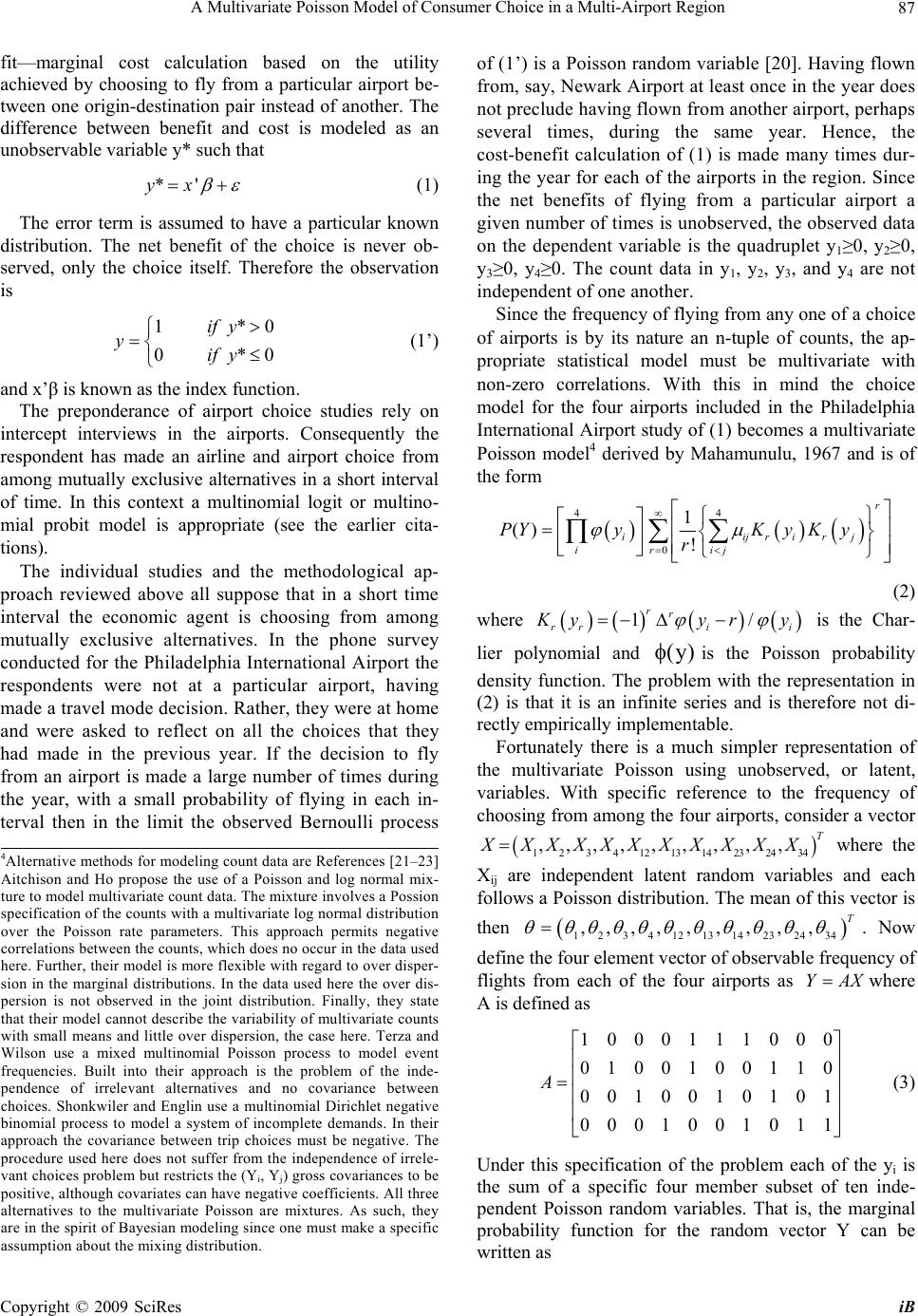 A Multivariate Poisson Model of Consumer Choice in a Multi-Airport Region87 fit—marginal cost calculation based on the utility achieved by choosing to fly from a particular airport be- tween one origin-destination pair instead of another. The difference between benefit and cost is modeled as an unobservable variable y* such that *'yx (1) The error term is assumed to have a particular known distribution. The net benefit of the choice is never ob- served, only the choice itself. Therefore the observation is 1* 0* if y yif y 0 0 (1’) and x’β is known as the index function. The preponderance of airport choice studies rely on intercept interviews in the airports. Consequently the respondent has made an airline and airport choice from among mutually exclusive alternatives in a short interval of time. In this context a multinomial logit or multino- mial probit model is appropriate (see the earlier cita- tions). The individual studies and the methodological ap- proach reviewed above all suppose that in a short time interval the economic agent is choosing from among mutually exclusive alternatives. In the phone survey conducted for the Philadelphia International Airport the respondents were not at a particular airport, having made a travel mode decision. Rather, they were at home and were asked to reflect on all the choices that they had made in the previous year. If the decision to fly from an airport is made a large number of times during the year, with a small probability of flying in each in- terval then in the limit the observed Bernoulli process of (1’) is a Poisson random variable [20]. Having flown from, say, Newark Airport at least once in the year does not preclude having flown from another airport, perhaps several times, during the same year. Hence, the cost-benefit calculation of (1) is made many times dur- ing the year for each of the airports in the region. Since the net benefits of flying from a particular airport a given number of times is unobserved, the observed data on the dependent variable is the quadruplet y1≥0, y2≥0, y3≥0, y4≥0. The count data in y1, y2, y3, and y4 are not independent of one another. Since the frequency of flying from any one of a choice of airports is by its nature an n-tuple of counts, the ap- propriate statistical model must be multivariate with non-zero correlations. With this in mind the choice model for the four airports included in the Philadelphia International Airport study of (1) becomes a multivariate Poisson model4 derived by Mahamunulu, 1967 and is of the form 44 0 1 () ! r iijrir rij i PYyK yK y r j (2) where 1/ rr rri i yyr )y( y is the Char- lier polynomial and is the Poisson probability density function. The problem with the representation in (2) is that it is an infinite series and is therefore not di- rectly empirically implementable. Fortunately there is a much simpler representation of the multivariate Poisson using unobserved, or latent, variables. With specific reference to the frequency of choosing from among the four airports, consider a vector where the Xij are independent latent random variables and each follows a Poisson distribution. The mean of this vector is then . Now define the four element vector of observable frequency of flights from each of the four airports as where A is defined as 1 2 3 4121314 23 24 34 ,,,, , , ,,,T XXXXXX XX XXX 1 2 3 412131423 24 3 ,,,, ,, ,,, Y 4 T AX 4Alternative methods for modeling count data are References [21–23] Aitchison and Ho propose the use of a Poisson and log normal mix- ture to model multivariate count data. The mixture involves a Possion specification of the counts with a multivariate log normal distribution over the Poisson rate parameters. This approach permits negative correlations between the counts, which does no occur in the data used here. Further, their model is more flexible with regard to over disper- sion in the marginal distributions. In the data used here the over dis- ersion is not observed in the joint distribution. Finally, they state that their model cannot describe the variability of multivariate counts with small means and little over dispersion, the case here. Terza and Wilson use a mixed multinomial Poisson process to model event frequencies. Built into their approach is the problem of the inde- endence of irrelevant alternatives and no covariance between choices. Shonkwiler and Englin use a multinomial Dirichlet negative inomial process to model a system of incomplete demands. In their approach the covariance between trip choices must be negative. The rocedure used here does not suffer from the independence of irrele- vant choices problem but restricts the (Yi, Yj) gross covariances to be ositive, although covariates can have negative coefficients. All three alternatives to the multivariate Poisson are mixtures. As such, they are in the spirit of Bayesian modeling since one must make a specific assumption about the mixing distribution. 1000111000 0100100110 0010010101 0001001011 A (3) Under this specification of the problem each of the yi is the sum of a specific four member subset of ten inde- pendent Poisson random variables. That is, the marginal probability function for the random vector Y can be written as Copyright © 2009 SciRes iB 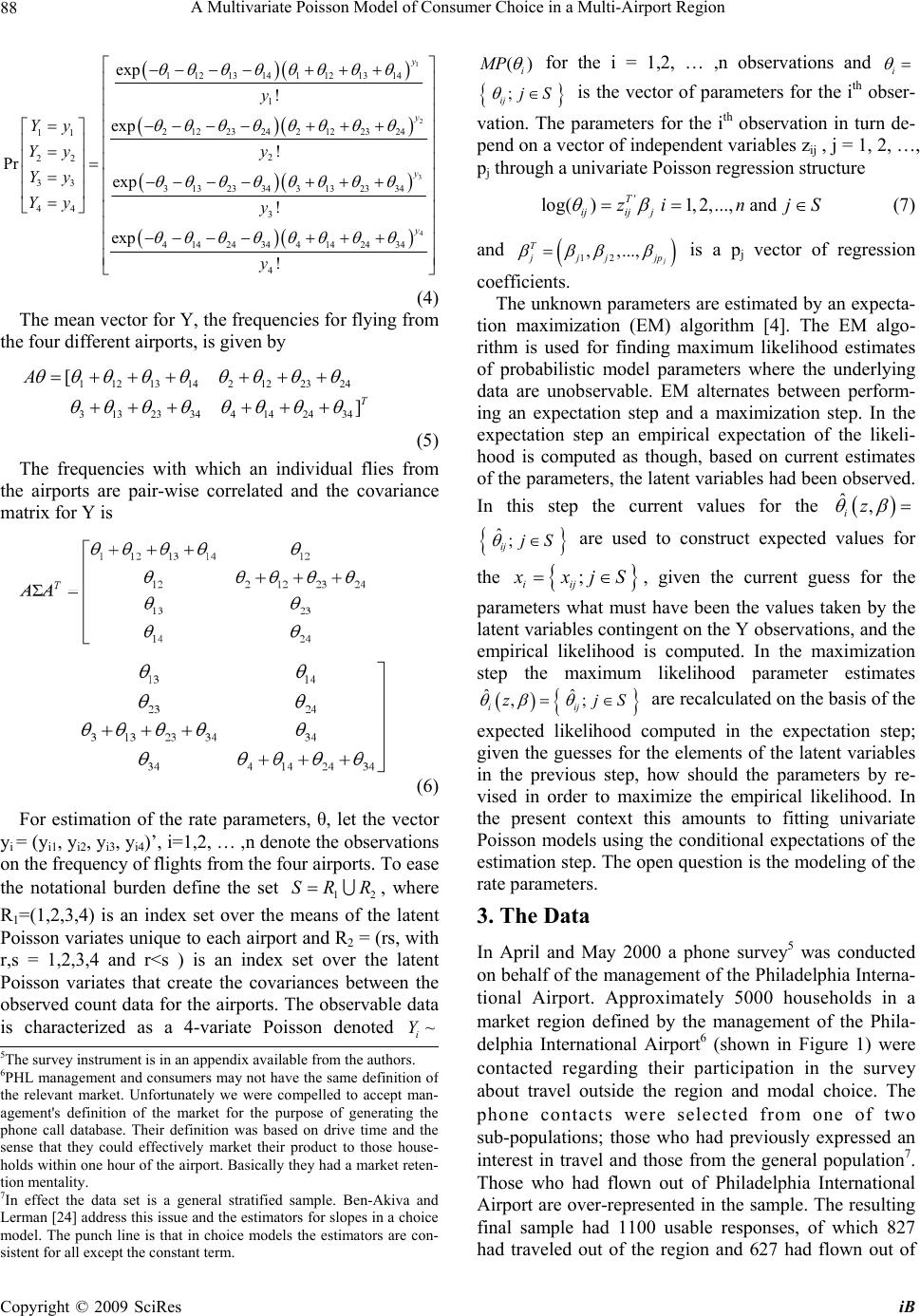 A Multivariate Poisson Model of Consumer Choice in a Multi-Airport Region Copyright © 2009 SciRes iB 88 1 2 3 4 11213141121314 1 21223242122324 11 2 22 33 313 23 34 313 23 34 44 3 414 24 34 414 24 34 4 exp ! exp ! Pr exp ! exp ! y y y y y Yy y Yy Yy Yy y y (4) The mean vector for Y, the frequencies for flying from the four different airports, is given by 1 1213 142122324 [A 31323344142434 ]T (5) The frequencies with which an individual flies from the airports are pair-wise correlated and the covariance matrix for Y is (6) For estimation of the rate parameters, θ, let the vector yi = (yi1, yi2, yi3, yi4)’, i=1,2, … ,n denote the observations on the frequency of flights from the four airports. To ease the notational burden define the set , where R1=(1,2,3,4) is an index set over the means of the latent Poisson variates unique to each airport and R2 = (rs, with r,s = 1,2,3,4 and r<s ) is an index set over the latent Poisson variates that create the covariances between the observed count data for the airports. The observable data is characterized as a 4-variate Poisson denoted 1 SRR2 ~ i Y () i MP for the i = 1,2, … ,n observations and i ; ij S log( is the vector of parameters for the ith obser- vation. The parameters for the ith observation in turn de- pend on a vector of independent variables zij , j = 1, 2, …, pj through a univariate Poisson regression structure ' )1, 2,...,and T ijij j zin j S (7) 12 ,,...,j jj j jp and T is a pj vector of regression coefficients. The unknown parameters are estimated by an expecta- tion maximization (EM) algorithm [4]. The EM algo- rithm is used for finding maximum likelihood estimates of probabilistic model parameters where the underlying data are unobservable. EM alternates between perform- ing an expectation step and a maximization step. In the expectation step an empirical expectation of the likeli- hood is computed as though, based on current estimates of the parameters, the latent variables had been observed. In this step the current values for the ˆ, iz ˆ; ij S are used to construct expected values for the ; jii xjS , given the current guess for the parameters what must have been the values taken by the latent variables contingent on the Y observations, and the empirical likelihood is computed. In the maximization step the maximum likelihood parameter estimates ˆ i ˆ ,; ij j zS are recalculated on the basis of the expected likelihood computed in the expectation step; given the guesses for the elements of the latent variables in the previous step, how should the parameters by re- vised in order to maximize the empirical likelihood. In the present context this amounts to fitting univariate Poisson models using the conditional expectations of the estimation step. The open question is the modeling of the rate parameters. 3. The Data In April and May 2000 a phone survey5 was conducted on behalf of the management of the Philadelphia Interna- tional Airport. Approximately 5000 households in a market region defined by the management of the Phila- delphia International Airport6 (shown in Figure 1) were contacted regarding their participation in the survey about travel outside the region and modal choice. The phone contacts were selected from one of two sub-populations; those who had previously expressed an interest in travel and those from the general population7. 5The survey instrument is in an appendix available from the authors. 6PHL management and consumers may not have the same definition o the relevant market. Unfortunately we were compelled to accept man- agement's definition of the market for the purpose of generating the hone call database. Their definition was based on drive time and the sense that they could effectively market their product to those house- holds within one hour of the airport. Basically they had a market reten- tion mentality. 7In effect the data set is a general stratified sample. Ben-Akiva and Lerman [24] address this issue and the estimators for slopes in a choice model. The punch line is that in choice models the estimators are con- sistent for all except the constant term. Those who had flown out of Philadelphia International Airport are over-represented in the sample. The resulting final sample had 1100 usable responses, of which 827 had traveled out of the region and 627 had flown out of 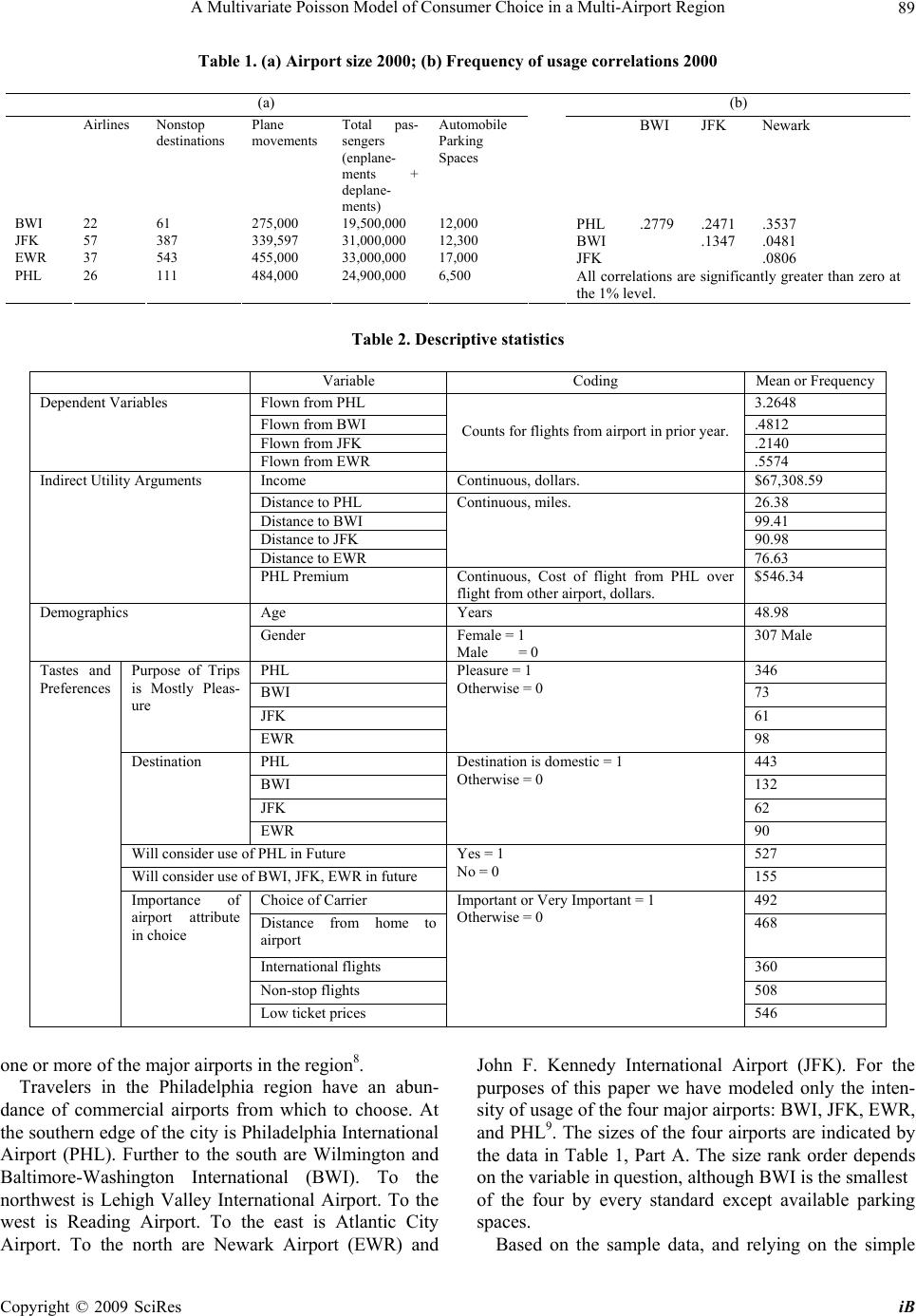 A Multivariate Poisson Model of Consumer Choice in a Multi-Airport Region 89 Table 1. (a) Airport size 2000; (b) Frequency of usage correlations 2000 (a) (b) Airlines Nonstop destinations Plane movements Total pas- sengers (enplane- ments + deplane- ments) Automobile Parking Spaces BWI JFK Newark BWI 22 61 275,000 19,500,000 12,000 PHL .2779 .2471 .3537 JFK 57 387 339,597 31,000,000 12,300 BWI .1347 .0481 EWR 37 543 455,000 33,000,000 17,000 JFK .0806 PHL 26 111 484,000 24,900,000 6,500 All correlations are significantly greater than zero at the 1% level. Table 2. Descriptive statistics Variable Coding Mean or Frequency Flown from PHL 3.2648 Flown from BWI .4812 Flown from JFK .2140 Dependent Variables Flown from EWR Counts for flights from airport in prior year. .5574 Income Continuous, dollars. $67,308.59 Distance to PHL 26.38 Distance to BWI 99.41 Distance to JFK 90.98 Distance to EWR Continuous, miles. 76.63 Indirect Utility Arguments PHL Premium Continuous, Cost of flight from PHL over flight from other airport, dollars. $546.34 Age Years 48.98 Demographics Gender Female = 1 Male = 0 307 Male PHL 346 BWI 73 JFK 61 Purpose of Trips is Mostly Pleas- ure EWR Pleasure = 1 Otherwise = 0 98 PHL 443 BWI 132 JFK 62 Destination EWR Destination is domestic = 1 Otherwise = 0 90 Will consider use of PHL in Future 527 Will consider use of BWI, JFK, EWR in future Yes = 1 No = 0 155 Choice of Carrier 492 Distance from home to airport 468 International flights 360 Non-stop flights 508 Tastes and Preferences Importance of airport attribute in choice Low ticket prices Important or Very Important = 1 Otherwise = 0 546 one or more of the major airports in the region8. Travelers in the Philadelphia region have an abun- dance of commercial airports from which to choose. At the southern edge of the city is Philadelphia International Airport (PHL). Further to the south are Wilmington and Baltimore-Washington International (BWI). To the northwest is Lehigh Valley International Airport. To the west is Reading Airport. To the east is Atlantic City Airport. To the north are Newark Airport (EWR) and John F. Kennedy International Airport (JFK). For the purposes of this paper we have modeled only the inten- sity of usage of the four major airports: BWI, JFK, EWR, and PHL9. The sizes of the four airports are indicated by the data in Table 1, Part A. The size rank order depends on the variable in question, although BWI is the smallest of the four by every standard except available parking spaces. Based on the sample data, and relying on the simple Copyright © 2009 SciRes iB 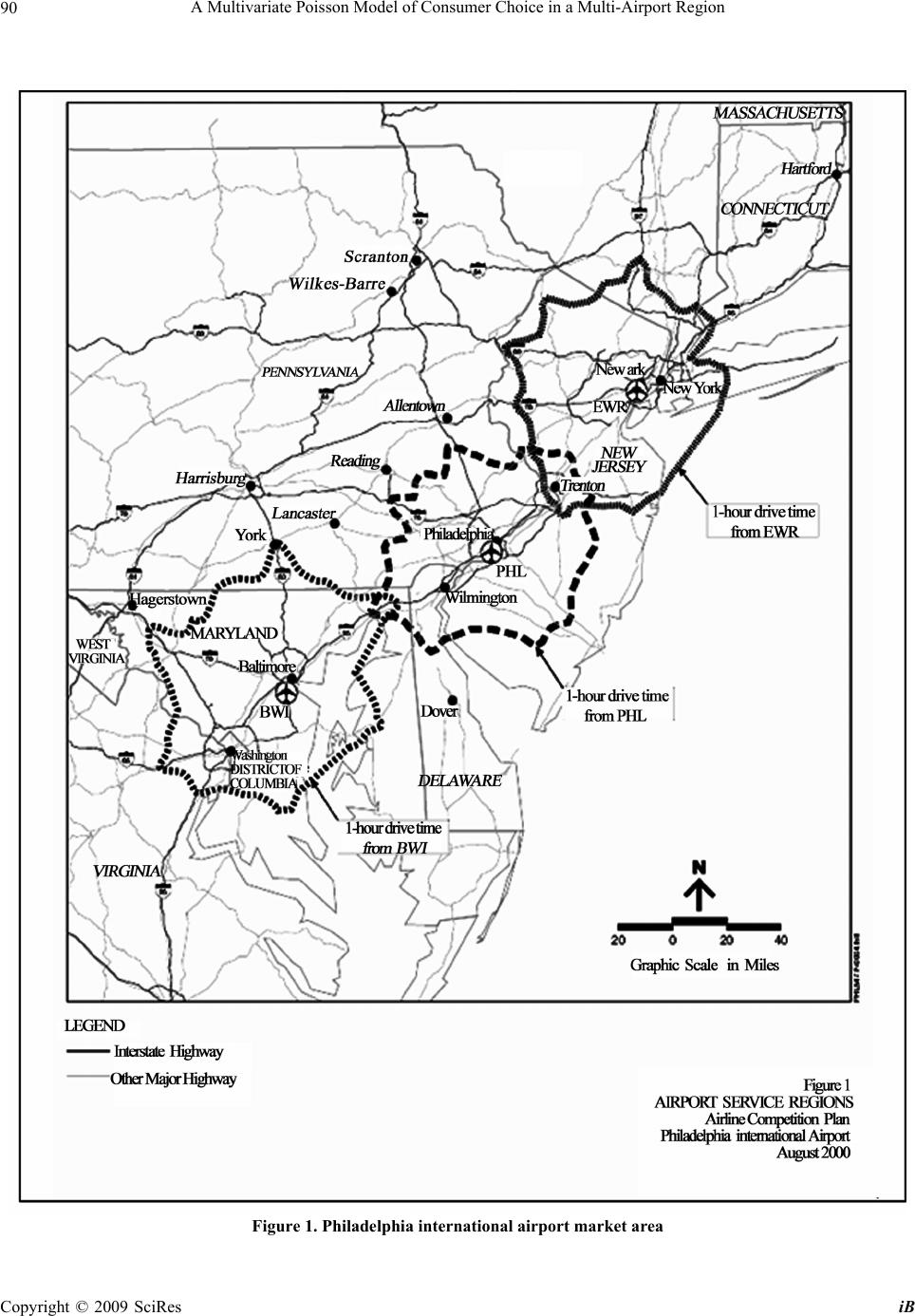 A Multivariate Poisson Model of Consumer Choice in a Multi-Airport Region 90 Figure 1. Philadelphia international airport market area Copyright © 2009 SciRes iB 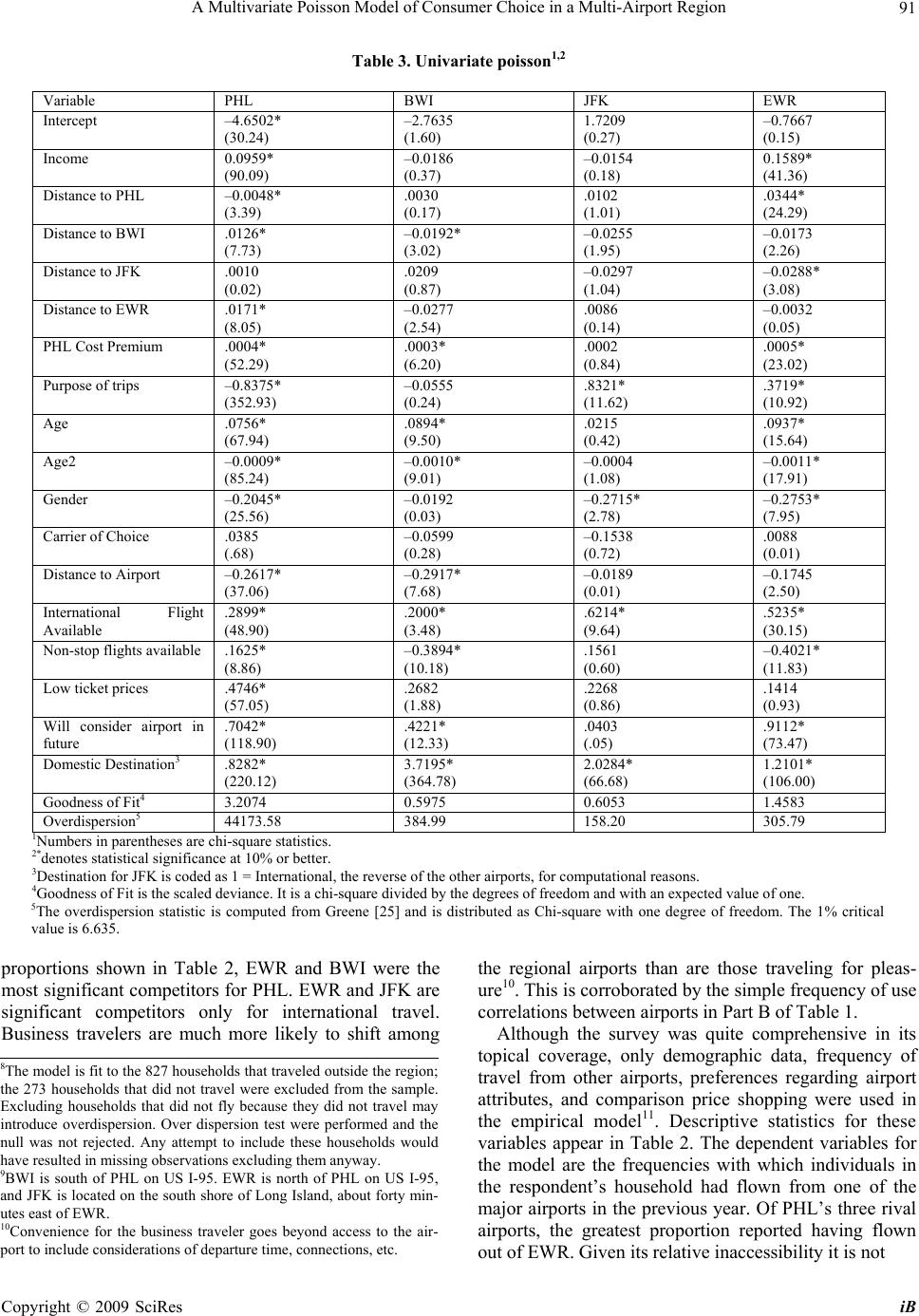 A Multivariate Poisson Model of Consumer Choice in a Multi-Airport Region Copyright © 2009 SciRes iB 91 Table 3. Univariate poisson1,2 Variable PHL BWI JFK EWR Intercept –4.6502* (30.24) –2.7635 (1.60) 1.7209 (0.27) –0.7667 (0.15) Income 0.0959* (90.09) –0.0186 (0.37) –0.0154 (0.18) 0.1589* (41.36) Distance to PHL –0.0048* (3.39) .0030 (0.17) .0102 (1.01) .0344* (24.29) Distance to BWI .0126* (7.73) –0.0192* (3.02) –0.0255 (1.95) –0.0173 (2.26) Distance to JFK .0010 (0.02) .0209 (0.87) –0.0297 (1.04) –0.0288* (3.08) Distance to EWR .0171* (8.05) –0.0277 (2.54) .0086 (0.14) –0.0032 (0.05) PHL Cost Premium .0004* (52.29) .0003* (6.20) .0002 (0.84) .0005* (23.02) Purpose of trips –0.8375* (352.93) –0.0555 (0.24) .8321* (11.62) .3719* (10.92) Age .0756* (67.94) .0894* (9.50) .0215 (0.42) .0937* (15.64) Age2 –0.0009* (85.24) –0.0010* (9.01) –0.0004 (1.08) –0.0011* (17.91) Gender –0.2045* (25.56) –0.0192 (0.03) –0.2715* (2.78) –0.2753* (7.95) Carrier of Choice .0385 (.68) –0.0599 (0.28) –0.1538 (0.72) .0088 (0.01) Distance to Airport –0.2617* (37.06) –0.2917* (7.68) –0.0189 (0.01) –0.1745 (2.50) International Flight Available .2899* (48.90) .2000* (3.48) .6214* (9.64) .5235* (30.15) Non-stop flights available .1625* (8.86) –0.3894* (10.18) .1561 (0.60) –0.4021* (11.83) Low ticket prices .4746* (57.05) .2682 (1.88) .2268 (0.86) .1414 (0.93) Will consider airport in future .7042* (118.90) .4221* (12.33) .0403 (.05) .9112* (73.47) Domestic Destination3 .8282* (220.12) 3.7195* (364.78) 2.0284* (66.68) 1.2101* (106.00) Goodness of Fit4 3.2074 0.5975 0.6053 1.4583 Overdispersion5 44173.58 384.99 158.20 305.79 1Numbers in parentheses are chi-square statistics. 2*denotes statistical significance at 10% or better. 3Destination for JFK is coded as 1 = International, the reverse of the other airports, for computational reasons. 4Goodness of Fit is the scaled deviance. It is a chi-square divided by the degrees of freedom and with an expected value of one. 5The overdispersion statistic is computed from Greene [25] and is distributed as Chi-square with one degree of freedom. The 1% critical value is 6.635. proportions shown in Table 2, EWR and BWI were the most significant competitors for PHL. EWR and JFK are significant competitors only for international travel. Business travelers are much more likely to shift among the regional airports than are those traveling for pleas- ure10. This is corroborated by the simple frequency of use correlations between airports in Part B of Table 1. Although the survey was quite comprehensive in its topical coverage, only demographic data, frequency of travel from other airports, preferences regarding airport attributes, and comparison price shopping were used in the empirical model11. Descriptive statistics for these variables appear in Table 2. The dependent variables for the model are the frequencies with which individuals in the respondent’s household had flown from one of the 8The model is fit to the 827 households that traveled outside the region; the 273 households that did not travel were excluded from the sample. Excluding households that did not fly because they did not travel may introduce overdispersion. Over dispersion test were performed and the null was not rejected. Any attempt to include these households would have resulted in missing observations excluding them anyway. 9BWI is south of PHL on US I-95. EWR is north of PHL on US I-95, and JFK is located on the south shore of Long Island, about forty min- utes east of EWR. 10Convenience for the business traveler goes beyond access to the air- ort to include considerations of departure time, connections, etc. major airports in the previous year. Of PHL’s three rival airports, the greatest proportion reported having flown out of EWR. Given its relative inaccessibility it is not 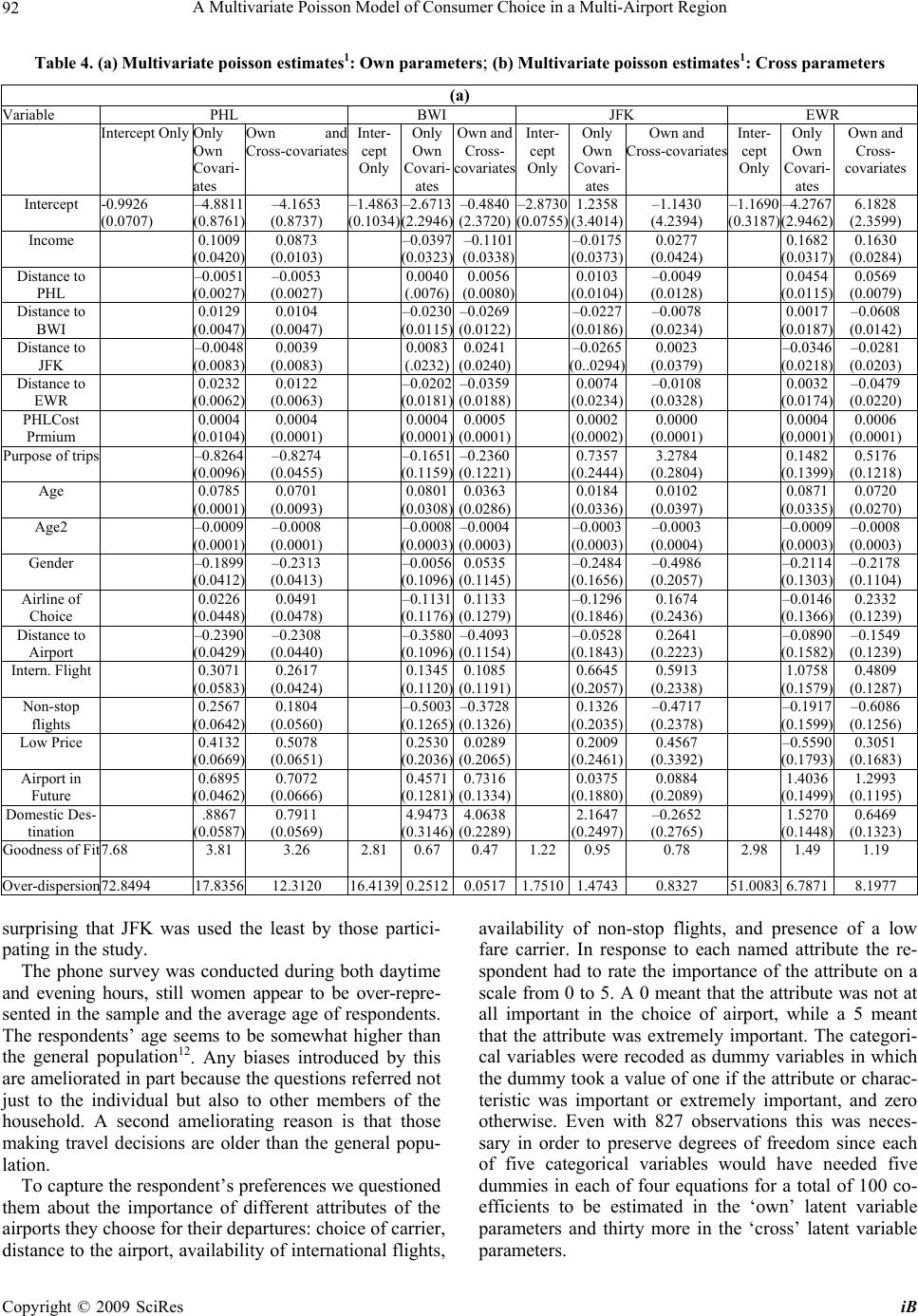 A Multivariate Poisson Model of Consumer Choice in a Multi-Airport Region 92 Table 4. (a) Multivariate poisson estimates1: Own paramet ers ; (b) Multivariate poisson estimates1: Cross parameters (a) Variable PHL BWI JFK EWR Intercept Only Only Own Covari- ates Own and Cross-covariates Inter- cept Only Only Own Covari- ates Own and Cross- covariates Inter- cept Only Only Own Covari- ates Own and Cross-covariates Inter- cept Only Only Own Covari- ates Own and Cross- covariates Intercept -0.9926 (0.0707) –4.8811 (0.8761) –4.1653 (0.8737) –1.4863 (0.1034) –2.6713 (2.2946) –0.4840 (2.3720) –2.8730 (0.0755) 1.2358 (3.4014) –1.1430 (4.2394) –1.1690 (0.3187) –4.2767 (2.9462) 6.1828 (2.3599) Income 0.1009 (0.0420) 0.0873 (0.0103) –0.0397 (0.0323) –0.1101 (0.0338) –0.0175 (0.0373) 0.0277 (0.0424) 0.1682 (0.0317) 0.1630 (0.0284) Distance to PHL –0.0051 (0.0027) –0.0053 (0.0027) 0.0040 (.0076) 0.0056 (0.0080) 0.0103 (0.0104) –0.0049 (0.0128) 0.0454 (0.0115) 0.0569 (0.0079) Distance to BWI 0.0129 (0.0047) 0.0104 (0.0047) –0.0230 (0.0115) –0.0269 (0.0122) –0.0227 (0.0186) –0.0078 (0.0234) 0.0017 (0.0187) –0.0608 (0.0142) Distance to JFK –0.0048 (0.0083) 0.0039 (0.0083) 0.0083 (.0232) 0.0241 (0.0240) –0.0265 (0..0294) 0.0023 (0.0379) –0.0346 (0.0218) –0.0281 (0.0203) Distance to EWR 0.0232 (0.0062) 0.0122 (0.0063) –0.0202 (0.0181) –0.0359 (0.0188) 0.0074 (0.0234) –0.0108 (0.0328) 0.0032 (0.0174) –0.0479 (0.0220) PHLCost Prmium 0.0004 (0.0104) 0.0004 (0.0001) 0.0004 (0.0001) 0.0005 (0.0001) 0.0002 (0.0002) 0.0000 (0.0001) 0.0004 (0.0001) 0.0006 (0.0001) Purpose of trips –0.8264 (0.0096) –0.8274 (0.0455) –0.1651 (0.1159) –0.2360 (0.1221) 0.7357 (0.2444) 3.2784 (0.2804) 0.1482 (0.1399) 0.5176 (0.1218) Age 0.0785 (0.0001) 0.0701 (0.0093) 0.0801 (0.0308) 0.0363 (0.0286) 0.0184 (0.0336) 0.0102 (0.0397) 0.0871 (0.0335) 0.0720 (0.0270) Age2 –0.0009 (0.0001) –0.0008 (0.0001) –0.0008 (0.0003) –0.0004 (0.0003) –0.0003 (0.0003) –0.0003 (0.0004) –0.0009 (0.0003) –0.0008 (0.0003) Gender –0.1899 (0.0412) –0.2313 (0.0413) –0.0056 (0.1096) 0.0535 (0.1145) –0.2484 (0.1656) –0.4986 (0.2057) –0.2114 (0.1303) –0.2178 (0.1104) Airline of Choice 0.0226 (0.0448) 0.0491 (0.0478) –0.1131 (0.1176) 0.1133 (0.1279) –0.1296 (0.1846) 0.1674 (0.2436) –0.0146 (0.1366) 0.2332 (0.1239) Distance to Airport –0.2390 (0.0429) –0.2308 (0.0440) –0.3580 (0.1096) –0.4093 (0.1154) –0.0528 (0.1843) 0.2641 (0.2223) –0.0890 (0.1582) –0.1549 (0.1239) Intern. Flight 0.3071 (0.0583) 0.2617 (0.0424) 0.1345 (0.1120) 0.1085 (0.1191) 0.6645 (0.2057) 0.5913 (0.2338) 1.0758 (0.1579) 0.4809 (0.1287) Non-stop flights 0.2567 (0.0642) 0.1804 (0.0560) –0.5003 (0.1265) –0.3728 (0.1326) 0.1326 (0.2035) –0.4717 (0.2378) –0.1917 (0.1599) –0.6086 (0.1256) Low Price 0.4132 (0.0669) 0.5078 (0.0651) 0.2530 (0.2036) 0.0289 (0.2065) 0.2009 (0.2461) 0.4567 (0.3392) –0.5590 (0.1793) 0.3051 (0.1683) Airport in Future 0.6895 (0.0462) 0.7072 (0.0666) 0.4571 (0.1281) 0.7316 (0.1334) 0.0375 (0.1880) 0.0884 (0.2089) 1.4036 (0.1499) 1.2993 (0.1195) Domestic Des- tination .8867 (0.0587) 0.7911 (0.0569) 4.9473 (0.3146) 4.0638 (0.2289) 2.1647 (0.2497) –0.2652 (0.2765) 1.5270 (0.1448) 0.6469 (0.1323) Goodness of Fit 7.68 3.813.26 2.810.670.47 1.220.950.78 2.98 1.49 1.19 Over-dispersion72.8494 17.835612.3120 16.41390.25120.05171.75101.47430.8327 51.0083 6.78718.1977 surprising that JFK was used the least by those partici- pating in the study. The phone survey was conducted during both daytime and evening hours, still women appear to be over-repre- sented in the sample and the average age of respondents. The respondents’ age seems to be somewhat higher than the general population12. Any biases introduced by this are ameliorated in part because the questions referred not just to the individual but also to other members of the household. A second ameliorating reason is that those making travel decisions are older than the general popu- lation. To capture the respondent’s preferences we questioned them about the importance of different attributes of the airports they choose for their departures: choice of carrier, distance to the airport, availability of international flights, availability of non-stop flights, and presence of a low fare carrier. In response to each named attribute the re- spondent had to rate the importance of the attribute on a scale from 0 to 5. A 0 meant that the attribute was not at all important in the choice of airport, while a 5 meant that the attribute was extremely important. The categori- cal variables were recoded as dummy variables in which the dummy took a value of one if the attribute or charac- teristic was important or extremely important, and zero otherwise. Even with 827 observations this was neces- sary in order to preserve degrees of freedom since each of five categorical variables would have needed five dummies in each of four equations for a total of 100 co- efficients to be estimated in the ‘own’ latent variable parameters and thirty more in the ‘cross’ latent variable parameters. Copyright © 2009 SciRes iB 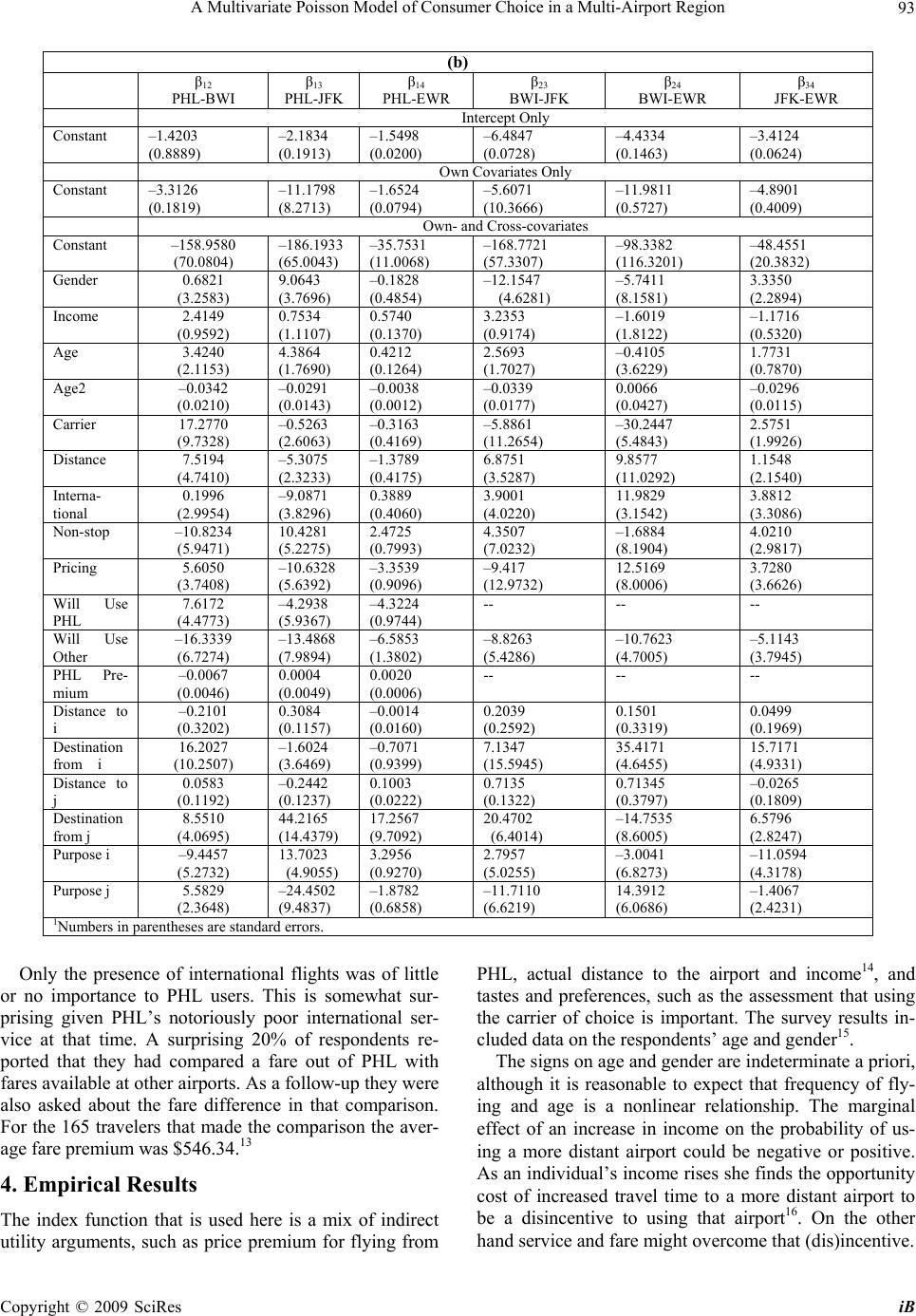 A Multivariate Poisson Model of Consumer Choice in a Multi-Airport Region 93 (b) β12 PHL-BWI β13 PHL-JFK β14 PHL-EWR β23 BWI-JFK β24 BWI-EWR β34 JFK-EWR Intercept Only Constant –1.4203 (0.8889) –2.1834 (0.1913) –1.5498 (0.0200) –6.4847 (0.0728) –4.4334 (0.1463) –3.4124 (0.0624) Own Covariates Only Constant –3.3126 (0.1819) –11.1798 (8.2713) –1.6524 (0.0794) –5.6071 (10.3666) –11.9811 (0.5727) –4.8901 (0.4009) Own- and Cross-covariates Constant –158.9580 (70.0804) –186.1933 (65.0043) –35.7531 (11.0068) –168.7721 (57.3307) –98.3382 (116.3201) –48.4551 (20.3832) Gender 0.6821 (3.2583) 9.0643 (3.7696) –0.1828 (0.4854) –12.1547 (4.6281) –5.7411 (8.1581) 3.3350 (2.2894) Income 2.4149 (0.9592) 0.7534 (1.1107) 0.5740 (0.1370) 3.2353 (0.9174) –1.6019 (1.8122) –1.1716 (0.5320) Age 3.4240 (2.1153) 4.3864 (1.7690) 0.4212 (0.1264) 2.5693 (1.7027) –0.4105 (3.6229) 1.7731 (0.7870) Age2 –0.0342 (0.0210) –0.0291 (0.0143) –0.0038 (0.0012) –0.0339 (0.0177) 0.0066 (0.0427) –0.0296 (0.0115) Carrier 17.2770 (9.7328) –0.5263 (2.6063) –0.3163 (0.4169) –5.8861 (11.2654) –30.2447 (5.4843) 2.5751 (1.9926) Distance 7.5194 (4.7410) –5.3075 (2.3233) –1.3789 (0.4175) 6.8751 (3.5287) 9.8577 (11.0292) 1.1548 (2.1540) Interna- tional 0.1996 (2.9954) –9.0871 (3.8296) 0.3889 (0.4060) 3.9001 (4.0220) 11.9829 (3.1542) 3.8812 (3.3086) Non-stop –10.8234 (5.9471) 10.4281 (5.2275) 2.4725 (0.7993) 4.3507 (7.0232) –1.6884 (8.1904) 4.0210 (2.9817) Pricing 5.6050 (3.7408) –10.6328 (5.6392) –3.3539 (0.9096) –9.417 (12.9732) 12.5169 (8.0006) 3.7280 (3.6626) Will Use PHL 7.6172 (4.4773) –4.2938 (5.9367) –4.3224 (0.9744) -- -- -- Will Use Other –16.3339 (6.7274) –13.4868 (7.9894) –6.5853 (1.3802) –8.8263 (5.4286) –10.7623 (4.7005) –5.1143 (3.7945) PHL Pre- mium –0.0067 (0.0046) 0.0004 (0.0049) 0.0020 (0.0006) -- -- -- Distance to i –0.2101 (0.3202) 0.3084 (0.1157) –0.0014 (0.0160) 0.2039 (0.2592) 0.1501 (0.3319) 0.0499 (0.1969) Destination from i 16.2027 (10.2507) –1.6024 (3.6469) –0.7071 (0.9399) 7.1347 (15.5945) 35.4171 (4.6455) 15.7171 (4.9331) Distance to j 0.0583 (0.1192) –0.2442 (0.1237) 0.1003 (0.0222) 0.7135 (0.1322) 0.71345 (0.3797) –0.0265 (0.1809) Destination from j 8.5510 (4.0695) 44.2165 (14.4379) 17.2567 (9.7092) 20.4702 (6.4014) –14.7535 (8.6005) 6.5796 (2.8247) Purpose i –9.4457 (5.2732) 13.7023 (4.9055) 3.2956 (0.9270) 2.7957 (5.0255) –3.0041 (6.8273) –11.0594 (4.3178) Purpose j 5.5829 (2.3648) –24.4502 (9.4837) –1.8782 (0.6858) –11.7110 (6.6219) 14.3912 (6.0686) –1.4067 (2.4231) 1Numbers in parentheses are standard errors. Only the presence of international flights was of little or no importance to PHL users. This is somewhat sur- prising given PHL’s notoriously poor international ser- vice at that time. A surprising 20% of respondents re- ported that they had compared a fare out of PHL with fares available at other airports. As a follow-up they were also asked about the fare difference in that comparison. For the 165 travelers that made the comparison the aver- age fare premium was $546.34.13 4. Empirical Results The index function that is used here is a mix of indirect utility arguments, such as price premium for flying from PHL, actual distance to the airport and income14, and tastes and preferences, such as the assessment that using the carrier of choice is important. The survey results in- cluded data on the respondents’ age and gender15. The signs on age and gender are indeterminate a priori, although it is reasonable to expect that frequency of fly- ing and age is a nonlinear relationship. The marginal effect of an increase in income on the probability of us- ing a more distant airport could be negative or positive. As an individual’s income rises she finds the opportunity cost of increased travel time to a more distant airport to be a disincentive to using that airport16. On the other hand service and fare might overcome that (dis)incentive. Copyright © 2009 SciRes iB 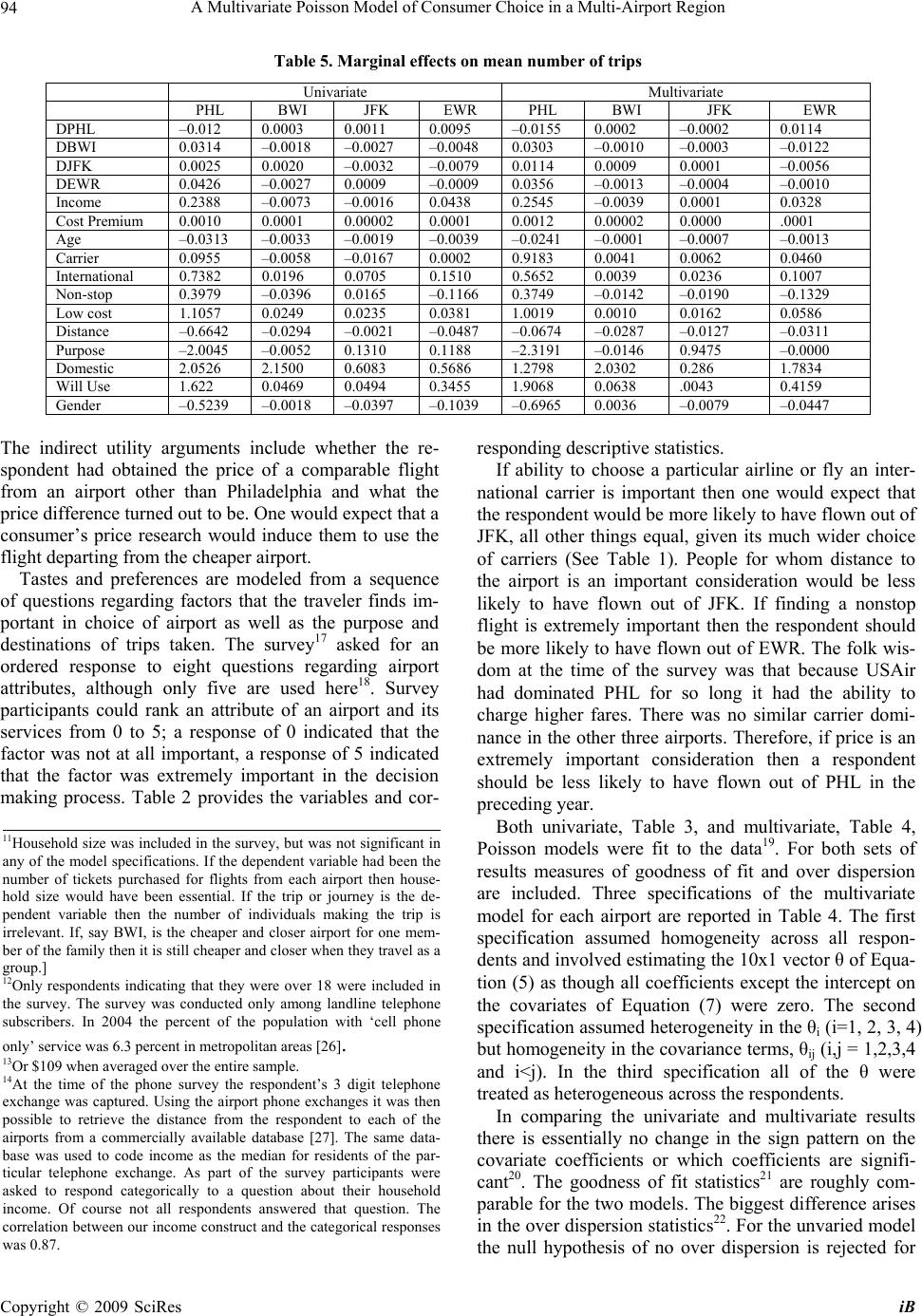 A Multivariate Poisson Model of Consumer Choice in a Multi-Airport Region 94 Table 5. Marginal effects on mean number of trips Univariate Multivariate PHL BWI JFK EWR PHL BWI JFK EWR DPHL –0.012 0.0003 0.0011 0.0095 –0.0155 0.0002 –0.0002 0.0114 DBWI 0.0314 –0.0018 –0.0027 –0.0048 0.0303 –0.0010 –0.0003 –0.0122 DJFK 0.0025 0.0020 –0.0032 –0.0079 0.0114 0.0009 0.0001 –0.0056 DEWR 0.0426 –0.0027 0.0009 –0.0009 0.0356 –0.0013 –0.0004 –0.0010 Income 0.2388 –0.0073 –0.0016 0.0438 0.2545 –0.0039 0.0001 0.0328 Cost Premium 0.0010 0.0001 0.00002 0.0001 0.0012 0.00002 0.0000 .0001 Age –0.0313 –0.0033 –0.0019 –0.0039 –0.0241 –0.0001 –0.0007 –0.0013 Carrier 0.0955 –0.0058 –0.0167 0.0002 0.9183 0.0041 0.0062 0.0460 International 0.7382 0.0196 0.0705 0.1510 0.5652 0.0039 0.0236 0.1007 Non-stop 0.3979 –0.0396 0.0165 –0.1166 0.3749 –0.0142 –0.0190 –0.1329 Low cost 1.1057 0.0249 0.0235 0.0381 1.0019 0.0010 0.0162 0.0586 Distance –0.6642 –0.0294 –0.0021 –0.0487 –0.0674 –0.0287 –0.0127 –0.0311 Purpose –2.0045 –0.0052 0.1310 0.1188 –2.3191 –0.0146 0.9475 –0.0000 Domestic 2.0526 2.1500 0.6083 0.5686 1.2798 2.0302 0.286 1.7834 Will Use 1.622 0.0469 0.0494 0.3455 1.9068 0.0638 .0043 0.4159 Gender –0.5239 –0.0018 –0.0397 –0.1039 –0.6965 0.0036 –0.0079 –0.0447 The indirect utility arguments include whether the re- spondent had obtained the price of a comparable flight from an airport other than Philadelphia and what the price difference turned out to be. One would expect that a consumer’s price research would induce them to use the flight departing from the cheaper airport. Tastes and preferences are modeled from a sequence of questions regarding factors that the traveler finds im- portant in choice of airport as well as the purpose and destinations of trips taken. The survey17 asked for an ordered response to eight questions regarding airport attributes, although only five are used here18. Survey participants could rank an attribute of an airport and its services from 0 to 5; a response of 0 indicated that the factor was not at all important, a response of 5 indicated that the factor was extremely important in the decision making process. Table 2 provides the variables and cor- responding descriptive statistics. If ability to choose a particular airline or fly an inter- national carrier is important then one would expect that the respondent would be more likely to have flown out of JFK, all other things equal, given its much wider choice of carriers (See Table 1). People for whom distance to the airport is an important consideration would be less likely to have flown out of JFK. If finding a nonstop flight is extremely important then the respondent should be more likely to have flown out of EWR. The folk wis- dom at the time of the survey was that because USAir had dominated PHL for so long it had the ability to charge higher fares. There was no similar carrier domi- nance in the other three airports. Therefore, if price is an extremely important consideration then a respondent should be less likely to have flown out of PHL in the preceding year. Both univariate, Table 3, and multivariate, Table 4, Poisson models were fit to the data19. For both sets of results measures of goodness of fit and over dispersion are included. Three specifications of the multivariate model for each airport are reported in Table 4. The first specification assumed homogeneity across all respon- dents and involved estimating the 10x1 vector θ of Equa- tion (5) as though all coefficients except the intercept on the covariates of Equation (7) were zero. The second specification assumed heterogeneity in the θi (i=1, 2, 3, 4) but homogeneity in the covariance terms, θij (i,j = 1,2,3,4 and i<j). In the third specification all of the θ were treated as heterogeneous across the respondents. 11Household size was included in the survey, but was not significant in any of the model specifications. If the dependent variable had been the number of tickets purchased for flights from each airport then house- hold size would have been essential. If the trip or journey is the de- endent variable then the number of individuals making the trip is irrelevant. If, say BWI, is the cheaper and closer airport for one mem- er of the family then it is still cheaper and closer when they travel as a group.] 12Only respondents indicating that they were over 18 were included in the survey. The survey was conducted only among landline telephone subscribers. In 2004 the percent of the population with ‘cell phone only’ service was 6.3 percent in metropolitan areas [26]. 13Or $109 when averaged over the entire sample. 14At the time of the phone survey the respondent’s 3 digit telephone exchange was captured. Using the airport phone exchanges it was then ossible to retrieve the distance from the respondent to each of the airports from a commercially available database [27]. The same data- base was used to code income as the median for residents of the par- ticular telephone exchange. As part of the survey participants were asked to respond categorically to a question about their household income. Of course not all respondents answered that question. The correlation between our income construct and the categorical responses was 0.87. In comparing the univariate and multivariate results there is essentially no change in the sign pattern on the covariate coefficients or which coefficients are signifi- cant20. The goodness of fit statistics21 are roughly com- parable for the two models. The biggest difference arises in the over dispersion statistics22. For the unvaried model the null hypothesis of no over dispersion is rejected for Copyright © 2009 SciRes iB 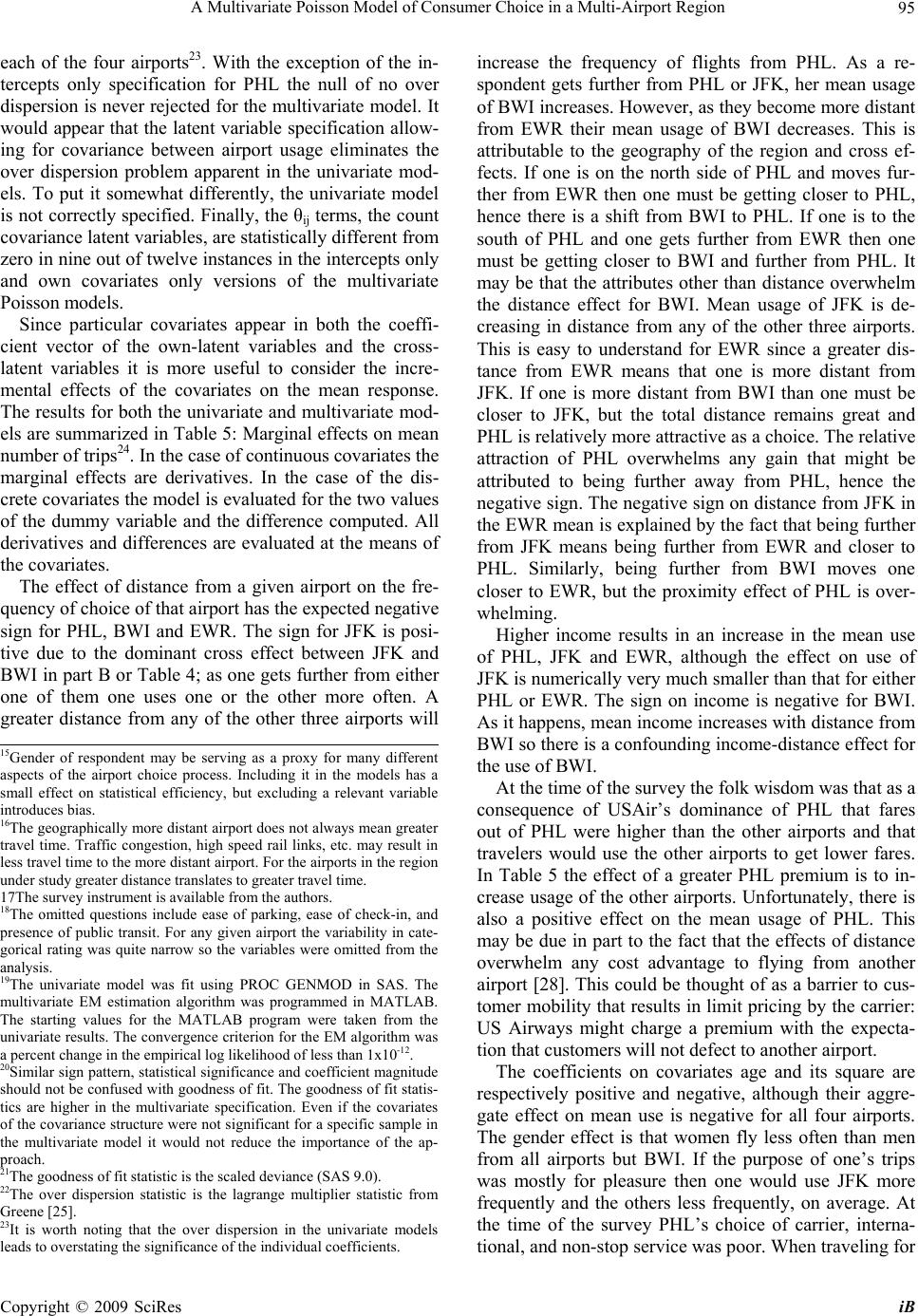 A Multivariate Poisson Model of Consumer Choice in a Multi-Airport Region95 each of the four airports23. With the exception of the in- tercepts only specification for PHL the null of no over dispersion is never rejected for the multivariate model. It would appear that the latent variable specification allow- ing for covariance between airport usage eliminates the over dispersion problem apparent in the univariate mod- els. To put it somewhat differently, the univariate model is not correctly specified. Finally, the θij terms, the count covariance latent variables, are statistically different from zero in nine out of twelve instances in the intercepts only and own covariates only versions of the multivariate Poisson models. Since particular covariates appear in both the coeffi- cient vector of the own-latent variables and the cross- latent variables it is more useful to consider the incre- mental effects of the covariates on the mean response. The results for both the univariate and multivariate mod- els are summarized in Table 5: Marginal effects on mean number of trips24. In the case of continuous covariates the marginal effects are derivatives. In the case of the dis- crete covariates the model is evaluated for the two values of the dummy variable and the difference computed. All derivatives and differences are evaluated at the means of the covariates. The effect of distance from a given airport on the fre- quency of choice of that airport has the expected negative sign for PHL, BWI and EWR. The sign for JFK is posi- tive due to the dominant cross effect between JFK and BWI in part B or Table 4; as one gets further from either one of them one uses one or the other more often. A greater distance from any of the other three airports will increase the frequency of flights from PHL. As a re- spondent gets further from PHL or JFK, her mean usage of BWI increases. However, as they become more distant from EWR their mean usage of BWI decreases. This is attributable to the geography of the region and cross ef- fects. If one is on the north side of PHL and moves fur- ther from EWR then one must be getting closer to PHL, hence there is a shift from BWI to PHL. If one is to the south of PHL and one gets further from EWR then one must be getting closer to BWI and further from PHL. It may be that the attributes other than distance overwhelm the distance effect for BWI. Mean usage of JFK is de- creasing in distance from any of the other three airports. This is easy to understand for EWR since a greater dis- tance from EWR means that one is more distant from JFK. If one is more distant from BWI than one must be closer to JFK, but the total distance remains great and PHL is relatively more attractive as a choice. The relative attraction of PHL overwhelms any gain that might be attributed to being further away from PHL, hence the negative sign. The negative sign on distance from JFK in the EWR mean is explained by the fact that being further from JFK means being further from EWR and closer to PHL. Similarly, being further from BWI moves one closer to EWR, but the proximity effect of PHL is over- whelming. Higher income results in an increase in the mean use of PHL, JFK and EWR, although the effect on use of JFK is numerically very much smaller than that for either PHL or EWR. The sign on income is negative for BWI. As it happens, mean income increases with distance from BWI so there is a confounding income-distance effect for the use of BWI. 15Gender of respondent may be serving as a proxy for many different aspects of the airport choice process. Including it in the models has a small effect on statistical efficiency, but excluding a relevant variable introduces bias. 16The geographically more distant airport does not always mean greater travel time. Traffic congestion, high speed rail links, etc. may result in less travel time to the more distant airport. For the airports in the region under study greater distance translates to greater travel time. 17The survey instrument is available from the authors. 18The omitted questions include ease of parking, ease of check-in, and resence of public transit. For any given airport the variability in cate- gorical rating was quite narrow so the varia les were omitted from the analysis. 19The univariate model was fit using PROC GENMOD in SAS. The multivariate EM estimation algorithm was programmed in MATLAB. The starting values for the MATLAB program were taken from the univariate results. The convergence criterion for the EM algorithm was a percent change in the empirical log likelihood of less than 1x10-12. 20Similar sign pattern, statistical significance and coefficient magnitude should not be confused with goodness of fit. The goodness of fit statis- tics are higher in the multivariate specification. Even if the covariates of the covariance structure were not significant for a specific sample in the multivariate model it would not reduce the importance of the ap- roach. 21The goodness of fit statistic is the scaled deviance (SAS 9.0). 22The over dispersion statistic is the lagrange multiplier statistic from Greene [25]. 23It is worth noting that the over dispersion in the univariate models leads to overstating the significance of the individual coefficients. At the time of the survey the folk wisdom was that as a consequence of USAir’s dominance of PHL that fares out of PHL were higher than the other airports and that travelers would use the other airports to get lower fares. In Table 5 the effect of a greater PHL premium is to in- crease usage of the other airports. Unfortunately, there is also a positive effect on the mean usage of PHL. This may be due in part to the fact that the effects of distance overwhelm any cost advantage to flying from another airport [28]. This could be thought of as a barrier to cus- tomer mobility that results in limit pricing by the carrier: US Airways might charge a premium with the expecta- tion that customers will not defect to another airport. The coefficients on covariates age and its square are respectively positive and negative, although their aggre- gate effect on mean use is negative for all four airports. The gender effect is that women fly less often than men from all airports but BWI. If the purpose of one’s trips was mostly for pleasure then one would use JFK more frequently and the others less frequently, on average. At the time of the survey PHL’s choice of carrier, interna- tional, and non-stop service was poor. When traveling for Copyright © 2009 SciRes iB 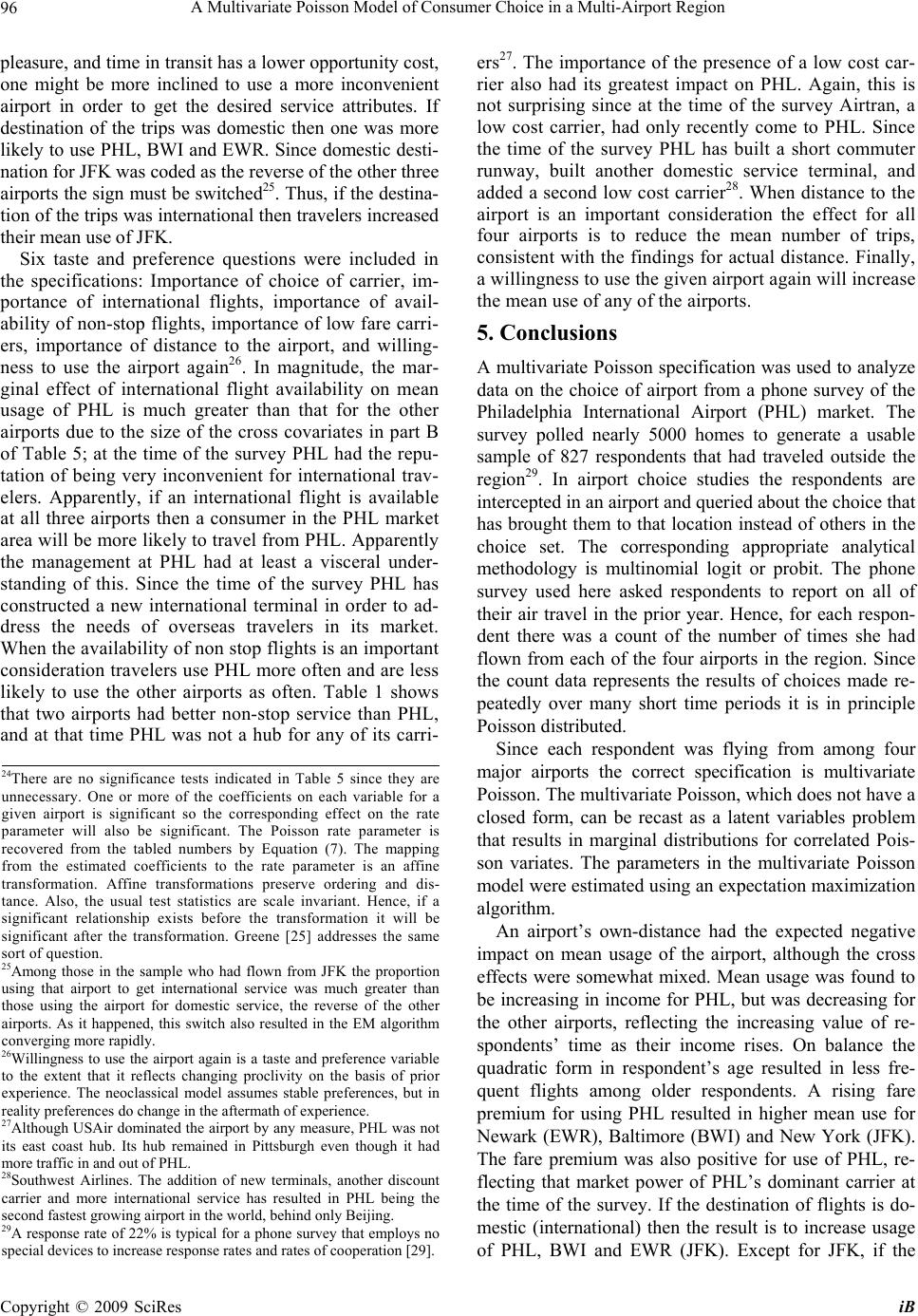 A Multivariate Poisson Model of Consumer Choice in a Multi-Airport Region 96 pleasure, and time in transit has a lower opportunity cost, one might be more inclined to use a more inconvenient airport in order to get the desired service attributes. If destination of the trips was domestic then one was more likely to use PHL, BWI and EWR. Since domestic desti- nation for JFK was coded as the reverse of the other three airports the sign must be switched25. Thus, if the destina- tion of the trips was international then travelers increased their mean use of JFK. Six taste and preference questions were included in the specifications: Importance of choice of carrier, im- portance of international flights, importance of avail- ability of non-stop flights, importance of low fare carri- ers, importance of distance to the airport, and willing- ness to use the airport again26. In magnitude, the mar- ginal effect of international flight availability on mean usage of PHL is much greater than that for the other airports due to the size of the cross covariates in part B of Table 5; at the time of the survey PHL had the repu- tation of being very inconvenient for international trav- elers. Apparently, if an international flight is available at all three airports then a consumer in the PHL market area will be more likely to travel from PHL. Apparently the management at PHL had at least a visceral under- standing of this. Since the time of the survey PHL has constructed a new international terminal in order to ad- dress the needs of overseas travelers in its market. When the availability of non stop flights is an important consideration travelers use PHL more often and are less likely to use the other airports as often. Table 1 shows that two airports had better non-stop service than PHL, and at that time PHL was not a hub for any of its carri- ers27. The importance of the presence of a low cost car- rier also had its greatest impact on PHL. Again, this is not surprising since at the time of the survey Airtran, a low cost carrier, had only recently come to PHL. Since the time of the survey PHL has built a short commuter runway, built another domestic service terminal, and added a second low cost carrier28. When distance to the airport is an important consideration the effect for all four airports is to reduce the mean number of trips, consistent with the findings for actual distance. Finally, a willingness to use the given airport again will increase the mean use of any of the airports. 5. Conclusions A multivariate Poisson specification was used to analyze data on the choice of airport from a phone survey of the Philadelphia International Airport (PHL) market. The survey polled nearly 5000 homes to generate a usable sample of 827 respondents that had traveled outside the region29. In airport choice studies the respondents are intercepted in an airport and queried about the choice that has brought them to that location instead of others in the choice set. The corresponding appropriate analytical methodology is multinomial logit or probit. The phone survey used here asked respondents to report on all of their air travel in the prior year. Hence, for each respon- dent there was a count of the number of times she had flown from each of the four airports in the region. Since the count data represents the results of choices made re- peatedly over many short time periods it is in principle Poisson distributed. Since each respondent was flying from among four major airports the correct specification is multivariate Poisson. The multivariate Poisson, which does not have a closed form, can be recast as a latent variables problem that results in marginal distributions for correlated Pois- son variates. The parameters in the multivariate Poisson model were estimated using an expectation maximization algorithm. 24There are no significance tests indicated in Table 5 since they are unnecessary. One or more of the coefficients on each variable for a given airport is significant so the corresponding effect on the rate arameter will also be significant. The Poisson rate parameter is recovered from the tabled numbers by Equation (7). The mapping from the estimated coefficients to the rate parameter is an affine transformation. Affine transformations preserve ordering and dis- tance. Also, the usual test statistics are scale invariant. Hence, if a significant relationship exists before the transformation it will be significant after the transformation. Greene [25] addresses the same sort of question. 25Among those in the sample who had flown from JFK the proportion using that airport to get international service was much greater than those using the airport for domestic service, the reverse of the other airports. As it happened, this switch also resulted in the EM algorithm converging more rapidly. 26Willingness to use the airport again is a taste and preference variable to the extent that it reflects changing proclivity on the basis of prio experience. The neoclassical model assumes stable preferences, but in reality preferences do change in the aftermath of experience. 27Although USAir dominated the airport by any measure, PHL was not its east coast hub. Its hub remained in Pittsburgh even though it had more traffic in and out of PHL. 28Southwest Airlines. The addition of new terminals, another discount carrier and more international service has resulted in PHL being the second fastest growing airport in the world, behind only Beijing. 29A response rate of 22% is typical for a phone survey that employs no special devices to increase response rates and rates of cooperation [29]. An airport’s own-distance had the expected negative impact on mean usage of the airport, although the cross effects were somewhat mixed. Mean usage was found to be increasing in income for PHL, but was decreasing for the other airports, reflecting the increasing value of re- spondents’ time as their income rises. On balance the quadratic form in respondent’s age resulted in less fre- quent flights among older respondents. A rising fare premium for using PHL resulted in higher mean use for Newark (EWR), Baltimore (BWI) and New York (JFK). The fare premium was also positive for use of PHL, re- flecting that market power of PHL’s dominant carrier at the time of the survey. If the destination of flights is do- mestic (international) then the result is to increase usage of PHL, BWI and EWR (JFK). Except for JFK, if the Copyright © 2009 SciRes iB 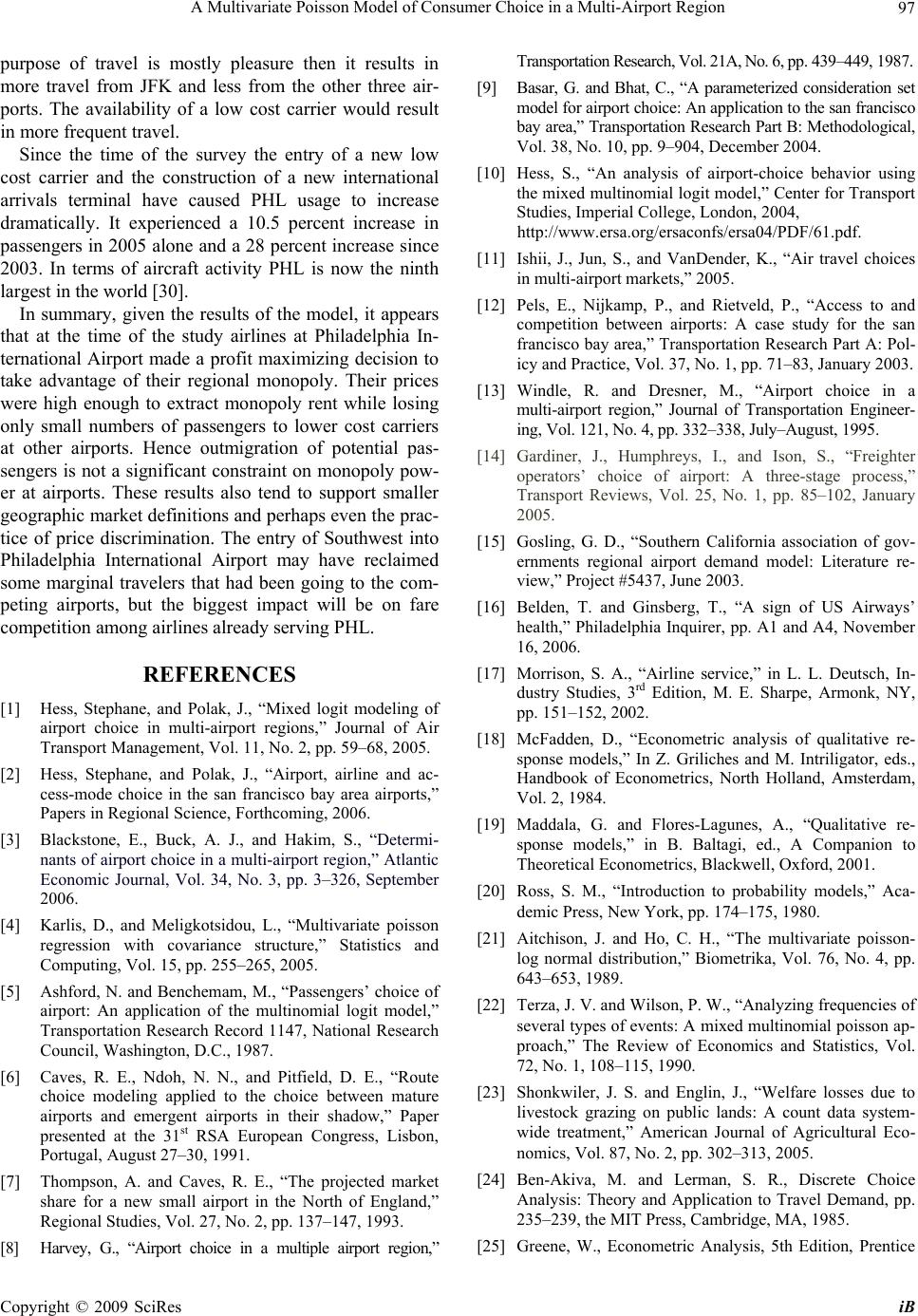 A Multivariate Poisson Model of Consumer Choice in a Multi-Airport Region97 purpose of travel is mostly pleasure then it results in more travel from JFK and less from the other three air- ports. The availability of a low cost carrier would result in more frequent travel. Since the time of the survey the entry of a new low cost carrier and the construction of a new international arrivals terminal have caused PHL usage to increase dramatically. It experienced a 10.5 percent increase in passengers in 2005 alone and a 28 percent increase since 2003. In terms of aircraft activity PHL is now the ninth largest in the world [30]. In summary, given the results of the model, it appears that at the time of the study airlines at Philadelphia In- ternational Airport made a profit maximizing decision to take advantage of their regional monopoly. Their prices were high enough to extract monopoly rent while losing only small numbers of passengers to lower cost carriers at other airports. Hence outmigration of potential pas- sengers is not a significant constraint on monopoly pow- er at airports. These results also tend to support smaller geographic market definitions and perhaps even the prac- tice of price discrimination. The entry of Southwest into Philadelphia International Airport may have reclaimed some marginal travelers that had been going to the com- peting airports, but the biggest impact will be on fare competition among airlines already serving PHL. REFERENCES [1] Hess, Stephane, and Polak, J., “Mixed logit modeling of airport choice in multi-airport regions,” Journal of Air Transport Management, Vol. 11, No. 2, pp. 59–68, 2005. [2] Hess, Stephane, and Polak, J., “Airport, airline and ac- cess-mode choice in the san francisco bay area airports,” Papers in Regional Science, Forthcoming, 2006. [3] Blackstone, E., Buck, A. J., and Hakim, S., “Determi- nants of airport choice in a multi-airport region,” Atlantic Economic Journal, Vol. 34, No. 3, pp. 3–326, September 2006. [4] Karlis, D., and Meligkotsidou, L., “Multivariate poisson regression with covariance structure,” Statistics and Computing, Vol. 15, pp. 255–265, 2005. [5] Ashford, N. and Benchemam, M., “Passengers’ choice of airport: An application of the multinomial logit model,” Transportation Research Record 1147, National Research Council, Washington, D.C., 1987. [6] Caves, R. E., Ndoh, N. N., and Pitfield, D. E., “Route choice modeling applied to the choice between mature airports and emergent airports in their shadow,” Paper presented at the 31st RSA European Congress, Lisbon, Portugal, August 27–30, 1991. [7] Thompson, A. and Caves, R. E., “The projected market share for a new small airport in the North of England,” Regional Studies, Vol. 27, No. 2, pp. 137–147, 1993. [8] Harvey, G., “Airport choice in a multiple airport region,” Transportation Research, Vol. 21A, No. 6, pp. 439–449, 1987. [9] Basar, G. and Bhat, C., “A parameterized consideration set model for airport choice: An application to the san francisco bay area,” Transportation Research Part B: Methodological, Vol. 38, No. 10, pp. 9–904, December 2004. [10] Hess, S., “An analysis of airport-choice behavior using the mixed multinomial logit model,” Center for Transport Studies, Imperial College, London, 2004, http://www.ersa.org/ersaconfs/ersa04/PDF/61.pdf. [11] Ishii, J., Jun, S., and VanDender, K., “Air travel choices in multi-airport markets,” 2005. [12] Pels, E., Nijkamp, P., and Rietveld, P., “Access to and competition between airports: A case study for the san francisco bay area,” Transportation Research Part A: Pol- icy and Practice, Vol. 37, No. 1, pp. 71–83, January 2003. [13] Windle, R. and Dresner, M., “Airport choice in a multi-airport region,” Journal of Transportation Engineer- ing, Vol. 121, No. 4, pp. 332–338, July–August, 1995. [14] Gardiner, J., Humphreys, I., and Ison, S., “Freighter operators’ choice of airport: A three-stage process,” Transport Reviews, Vol. 25, No. 1, pp. 85–102, January 2005. [15] Gosling, G. D., “Southern California association of gov- ernments regional airport demand model: Literature re- view,” Project #5437, June 2003. [16] Belden, T. and Ginsberg, T., “A sign of US Airways’ health,” Philadelphia Inquirer, pp. A1 and A4, November 16, 2006. [17] Morrison, S. A., “Airline service,” in L. L. Deutsch, In- dustry Studies, 3rd Edition, M. E. Sharpe, Armonk, NY, pp. 151–152, 2002. [18] McFadden, D., “Econometric analysis of qualitative re- sponse models,” In Z. Griliches and M. Intriligator, eds., Handbook of Econometrics, North Holland, Amsterdam, Vol. 2, 1984. [19] Maddala, G. and Flores-Lagunes, A., “Qualitative re- sponse models,” in B. Baltagi, ed., A Companion to Theoretical Econometrics, Blackwell, Oxford, 2001. [20] Ross, S. M., “Introduction to probability models,” Aca- demic Press, New York, pp. 174–175, 1980. [21] Aitchison, J. and Ho, C. H., “The multivariate poisson- log normal distribution,” Biometrika, Vol. 76, No. 4, pp. 643–653, 1989. [22] Terza, J. V. and Wilson, P. W., “Analyzing frequencies of several types of events: A mixed multinomial poisson ap- proach,” The Review of Economics and Statistics, Vol. 72, No. 1, 108–115, 1990. [23] Shonkwiler, J. S. and Englin, J., “Welfare losses due to livestock grazing on public lands: A count data system- wide treatment,” American Journal of Agricultural Eco- nomics, Vol. 87, No. 2, pp. 302–313, 2005. [24] Ben-Akiva, M. and Lerman, S. R., Discrete Choice Analysis: Theory and Application to Travel Demand, pp. 235–239, the MIT Press, Cambridge, MA, 1985. [25] Greene, W., Econometric Analysis, 5th Edition, Prentice Copyright © 2009 SciRes iB 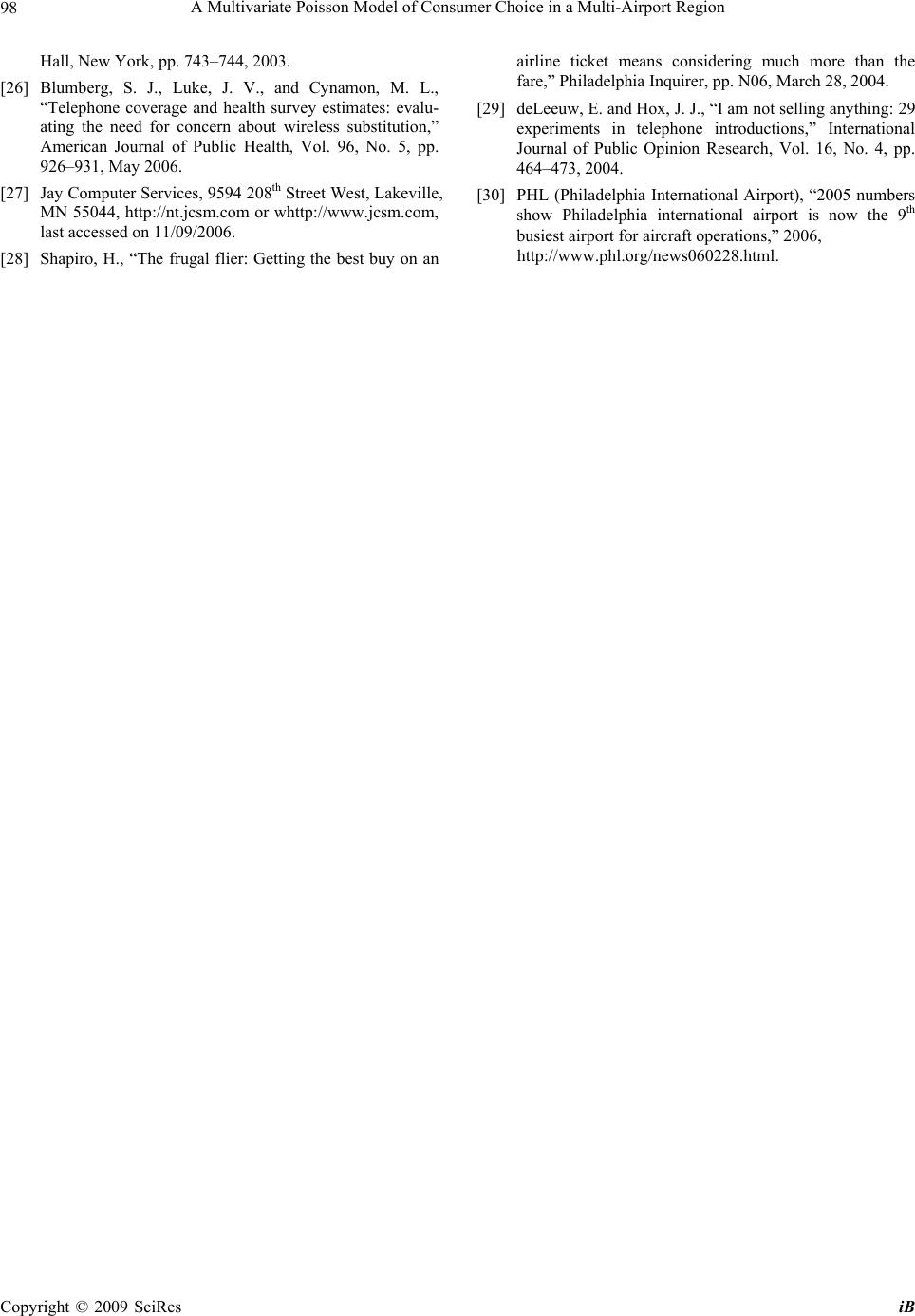 A Multivariate Poisson Model of Consumer Choice in a Multi-Airport Region Copyright © 2009 SciRes iB 98 Hall, New York, pp. 743–744, 2003. [26] Blumberg, S. J., Luke, J. V., and Cynamon, M. L., “Telephone coverage and health survey estimates: evalu- ating the need for concern about wireless substitution,” American Journal of Public Health, Vol. 96, No. 5, pp. 926–931, May 2006. [27] Jay Computer Services, 9594 208th Street West, Lakeville, MN 55044, http://nt.jcsm.com or whttp://www.jcsm.com, last accessed on 11/09/2006. [28] Shapiro, H., “The frugal flier: Getting the best buy on an airline ticket means considering much more than the fare,” Philadelphia Inquirer, pp. N06, March 28, 2004. [29] deLeeuw, E. and Hox, J. J., “I am not selling anything: 29 experiments in telephone introductions,” International Journal of Public Opinion Research, Vol. 16, No. 4, pp. 464–473, 2004. [30] PHL (Philadelphia International Airport), “2005 numbers show Philadelphia international airport is now the 9th busiest airport for aircraft operations,” 2006, http://www.phl.org/news060228.html.
|